#as its instead like. only used to further illustrate the struggles and themes of the regular life stuff. only in a more dramatic format
Explore tagged Tumblr posts
Text
The Immortal Mike Mulligan and His Magic Steam Shovel

Mike Mulligan And His Steam Shovel is a classic children's tale about an American Adam and his mechanical familiar struggling to adjust to the changing times. But what else does this cozy story teach us?

How To Start A Blog Post
Some of you may be familiar with a little classic called Mike Mulligan and His Steam Shovel, written and illustrated by Virginia Lee Burton, which you may have read as a child, or perhaps chances are you’re familiar with the movie and its gloriously persistent earworms.
But for the sake of the uninitiated and those who might need a refresher, Mike Mulligan and His Steam Shovel is a children’s book first published in 1939 during The Great Depression and later adapted into a 25-minute animated short film aired by HBO in 1990.
The book depicts the rise and fall of the steam shovel and its effect on the working class. Mike Mulligan, the symbol of then-modern industrial America, is made to face the reality that progress births new machines and he (as well as Mary Anne) must adapt to the changing times or fall into obscurity. Like in much of Virginia Lee Burton’s children’s books, the overlying theme is the importance of the power of friendship, and old-fashioned hard work and ingenuity in overcoming adversity and embracing change together. Or at least that’s a pattern I noticed in her stories that I’m familiar with.
The short film was animated in the style of Burton’s illustrations and is a very closely adapted read-through of the book interspersed with song sequences, so if you haven’t watched it yet and want to, it can be found on Youtube. Since the story is short and to the point, I will be spoiling all of it, so definitely go watch it first if you want to experience it for yourself before I ruin it.
But first, a brief history lesson!

A Rough Timeline Of The Steam Shovel’s Role In History
1796: Grimshaw of Boulton & Watt devised the first steam-powered excavator.
1833: William Brunton patented another steam-powered excavator which he provided further details on in 1836.
1839: William Otis received a patent for his steam shovel design and is credited as its inventor.
1854-1859: First large-scale use of steam power in North America is the construction of the Grand Trunk Railway Victoria Bridge over the St. Lawrence River at Montreal.
1861-1865: American Civil War happens. Although excavators are starting to be used in the construction of the foundation of city buildings, the initial cost of the machines was high and the funds were low, particularly leading up to and during the war. Section gangs of men (a method perfected for work on railroads) were paid the costly wages of manual labor instead of hiring bulky expensive machines that would be difficult to maneuver and power throughout the construction site.
1884: Changes to the popular shovel design have been made by this point, but here the full-swing 360° revolving shovel was developed in England and became the preferred model. Expanding railway networks in the US and UK create high demand for steam shovels. The Marion Power Shovel Company, an American manufacturer, was founded and I mention this because it seems to be where Mary Anne got her name from in the book. Cute Easter Egg reference there.
1890: By this point, costs of non-powered labor for the construction of skyscrapers had risen to the point where switching over to steam power was the only option and the practice took off from there.
1904 -1914: The US took over the Panama Canal dig from France (which had started in 1881 but quit due to engineering problems and high worker mortality rates). One hundred and two (102) shovels worked in that decade-long dig: 77 were built by Bucyrus; the remaining 25 were Marion shovels. The shovel crews would race to see who could move the most dirt.
1914-1918: World War 1 starts a mere 2 weeks and 3 days before the Panama Canal officially opens.
????: At some point during all this, shovels start being used for mining and quarry work around the world and become more present in general construction operations.
1920s: Shovels gain more traction with the publicly funded road building programs around North America. Thousands of miles of State Highways were built during this time period, together with new factories, docks, ports, buildings, and grain elevators.
1929: The Great Depression began with the stock market crash.
1930s: Steam shovels lost out to the simpler, cheaper diesel-powered excavating shovels that were the forerunners of those still in use today.
1939-1945: World War 2 happened and… power shovel technology just kept advancing until the relics of the past became monuments to history. But hey, at least the Great Depression ended.

A historic Marion Steam Shovel located on Gulf Road in the Town of Le Roy, New York, United States.

In Which I Summarize The Plot
The tale of Mike Mulligan is a variation on the compelling classic of an American Adam alongside the likes of Rip Van Winkle, Paul Bunyan, and John Henry who walked before him. This archetype is a solitary figure – a self-made man, representative of immense possibilities, who follows his own whims or moral compass and is made vulnerable by his own ambition and optimism. He has a vision for the future of America that is inevitably altered and shaped by his experiences throughout the story. Generally, the American Adam will find himself faced with a change in the status quo and will have to either fight for “the old way” or adapt, becoming a symbol for the people around him in the process.
Mike’s story begins with the steam shovel’s rise to fame. He and Mary Anne dug canals, they “moved mountains” to make way for railroads, they flattened the land for highways and airports to be built, and they dig cellars for city skyscrapers. Just the promise of getting to see Mike and Mary Anne in action is enough to draw crowds to their construction sites. After all, part of the romantic appeal of steam shovels was watching them work, as you could see its wires and gears move while it operated. In exchange, having an audience to perform for encourages Mike and Mary Anne to work faster and better – something they are both quite proud of.
But then everything changed when the gasoline, electric, and diesel shovels entered the scene.
These new models were cheaper to maintain and could therefore be worked harder for less expense. As a result, Mike winds up unable to find a job because he refuses to give up Mary Anne and the old way. Instead, he is more than ever determined to prove their worth. Mike had always said he believed Mary Anne “could dig as much in a day as a hundred men could dig in a week” and he gets his chance to prove it when he drives Mary Anne out to a small town that is looking to have a cellar dug out for their new town hall.
Before he can be turned away, he places his bet that Mary Anne can dig the cellar in just one day and offers to accept no payment if he can’t live up to that boast – a hard offer for any stingy capitalist to refuse. So, he starts digging at sunrise the following day and basically within the span of a song sequence five whole towns have flocked to this hole in the ground to watch them work, and naturally that means Mike and Mary Anne make the deadline just as the sun sets. The only catch is that they’ve forgotten to leave a way out of the hole, so they’re stuck and the sly selectman Henry B. Swap says they won’t get paid on a technicality.
Fun fact: this is where Virginia Lee Burton realized she had literally dug her characters into a corner until 12-year-old family friend Dick Berkenbush, inspired by the steam heating system in his father’s garage, suggested turning Mary Anne into a furnace for the new town hall. (For a little more on Dick, I recommend checking out Melinda Johnson’s picture book review.) Burton rolled with this idea and credited him with a footnote on that page of the book where a young boy is shown as presenting the solution of making Mary Anne the furnace and hiring Mike as the janitor.
Everyone agrees that this is a good plan and both of our heroes get to retire for the rest of their days, satisfied with their final accomplishment. It’s a nice and simple story, but I have some thoughts.

The Part Where I Overthink Children’s Literature For Fun
Mike Mulligan is clearly an immortal god who’s having a rough time adjusting to the changing times and it shows.
First of all, I cannot stress enough that Mike and Mary Anne were there from The Beginning. “It was Mike Mulligan and Mary Anne and some others” who changed the shape of the land “for years and years.” Looking back at our trusty timeline, this was progress that realistically took decades to accomplish and these two were there on the front lines to pioneer these developments! Neither Mike nor Mary Anne ever ages. She hasn’t suffered the wear and tear of years of hard work because Mike has been keeping her spotless and in tip top shape as if it were still the day she had been created for mass production. But you’re telling me that a man who smokes like a chimney still looks as baby-faced as he was in his youth after decades of dedicated hard labor?
I’m just saying there’s some kind of magic at work here that is only enhanced by the strength of their companionship. The more charisma they exude, the more people they attract to watch them work. The bigger the crowd around them grows to be, the better and faster and harder they work. The louder the standing ovation they receive from their accomplishments, the more they seem to glow in all their youthful glory. The years just melt right off them and it all hinges on this system they have developed between them! They have a very codependent relationship. One could not achieve this result without the other.
For one thing, Mike doesn’t seem to have a stationary home to return to at any point. The movie shows him in the garage of a house in the beginning, but according to the book he appears to live inside Mary Anne’s compartment and uses her to travel from one job to the next. There’s one scene after the “No Steam Shovels Wanted” segment where he’s sitting outside, moping about how no one wants him and Mary Anne anymore, which is honestly an understandable reaction from anyone who has just realized the job market has shut them out from continuing to make a living. But this man is never depicted as having any attachments beyond Mary Anne, so I am inclined to believe that he doesn’t have a family to miss him either, which would therefore make Mary Anne both his home and his family.

Speaking of Mary Anne, let’s talk about the fact that steam shovels and their electric, diesel, and gasoline powered counterparts are sentient in this world. When we see the steam shovels in the scrap yard, they even have faces like Mary Anne does. This was mass genocide! They were murdered and their corpses were tossed in a heap like it was no big deal. Just look at Mary Anne. She is horrified. No wonder Mike is so repulsed by the idea of condemning her!
Yes, this is a children’s book and, in a lot of children’s media, most inanimate objects and animals are given sentience as a way to encourage children to emotionally relate to them – the sun has a face and one of the horses even TALKS by the end of the movie – but come on… this was terrifyingly dark, especially when you look at the imagery. The other three antagonist shovels are so blissfully unaware of the fate that may one day await them in that pit. Sure, they are shiny and new and exciting now, but the moment they fail to live up to the standard set for them, their human overlords will reduce them to scrap metal just as quickly because they are all still machines after all… Sentient machines, albeit, but that evidently means nothing to the majority of mankind.
Furthermore, due to her sentience, Mary Anne can operate without Mike pulling her levers as long as the fire within her remains lit. Perhaps the fire is what keeps her alive, considering the major difference between her and the others in the pit is that their fires eventually went out and they were left to rust in a junkyard until their eventual dismemberment. This would seem to imply that the relationship between her and Mike is one of master and familiar. He keeps her fire burning and shares his eternal youth with her, and she does the physical labor for him in return.
But the big question that has yet to be answered is this: which of them is channeling the energy of the onlookers and converting it directly into power for Mary Anne while they work? Is Mike the catalyst or is Mary Anne?
Which leads us into the climax of the story and a lot more food for thought…
Five whole towns worth of people just take the day off from their jobs and their lives to watch this guy dig a hole in the ground. The fire department, the doctors, and even the police! I sure hope there aren’t any actual fires, public safety violations, or general health crises to tend to for the day because clearly this strange man and his steam shovel are far more important. After all, they’re going to need a lot of power to pull off this bet and if five towns have to become living batteries to do it – well! You only live once, right? You may as well see something worth your time!
So, if Mike spent the entire day from sunrise to sunset digging that cellar to the point where he left himself no way to get out of that hole, when and where did he go to the bathroom? Did he just hold it in the entire time? Did he pop a squat in a corner with everyone looking on? Does he just not have any need for mortal bodily functions? I don’t have the answers, but it warrants asking.

And then, the townspeople make a big fuss about what they’re going to do about leaving Mike and Mary Anne in the pit for a while until someone goes to get a ladder to climb down to talk to him as though they hadn’t just collectively been screaming down into the pit the entire time. He can HEAR you, you know! The moment they have his verbal agreement to the plan, they begin building the town hall around our two immortal heroes without further ado, so what I want to know is did they just shake his hand, then climb out of the pit and yoink the ladder up after them before he could climb up? “Sorry, buddy, we know you just accomplished this impossible task and honestly we’re not quite sure how to feel about it while the adrenaline’s still injecting itself straight into our hearts, but you’re stuck down there now. You live here.”
At least the construction is finished before winter, so he hasn’t been freezing down there in that hole for months, but how did they line the cellar with concrete while Mike was inside? Was he sitting in Mary Anne’s compartment the entire time while it set and everyone else worked? Did anyone feed him? Does he even eat? Mrs. McGillicuddy brings him a fresh-baked apple pie every day once the town hall is built, so I wonder if she has been doing this since that first day he arrived. Could that be all she feeds him? I will admit that there is something poetic about an American Adam sustaining himself on that coveted all-American apple pie life. It’s like two tropes being married into one concentrated dose of the American Dream so pungent it hurts.
Maybe Mary Anne is the source of his power after all and that’s why he can’t leave her. And now he’s stuck there with her in that cellar forever, trying to make the most of it. He didn’t get his job back, he didn’t get the exact happy ending he’d been hoping for, he didn’t prove steam power was better than the competition… but at least he has a sweet gig as a janitor in a town that hails him as a hero and he technically does have a fixed home now.
Mary Anne, on the other hand, has completely had her freedom taken away from her. She may not have been murdered and reduced to scrap metal in the junkyard, but she is unable to travel or go outside ever again. It’s supposed to be heartwarming that she and Mike have found a different way to be useful… a different purpose than the one they had had all their lives… but it does feel pretty morbid when you realize this was done to Mary Anne intentionally without her permission. But you know… it could be worse…
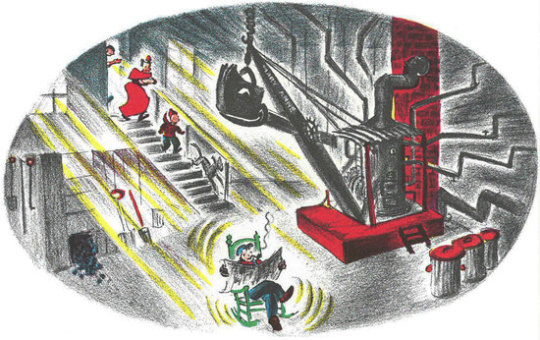

Some Sources and Interesting Material
You can find more information about Virginia Lee Burton’s work on the Houghton Mifflin website. The Virginia Lee Burton and Steam Shovel Wikipedia pages were also incredibly helpful for me while I was pulling together the context I needed to create a rough timeline, but you can read a briefer examination of Mike Mulligan and His Steam Shovel‘s historical context in this Newsweek article.
If you are interested in more in-depth reading material, I recommend Rise of the New York skyscraper, 1865-1913 by Sarah Landau. The excerpts I read to help fill out my timeline were fascinating. Alternatively, if you’re looking for something more philosophical to sink your teeth into, The Prindle Institute offers food for thought regarding the book’s themes.
Last but certainly not least, check out American Adam Myth for some other examples of characters in literature and how the trope evolved!
Note: This article was originally posted on WordPress on July 4, 2021.
#Mike Mulligan And His Steam Shovel#Virginia Lee Burton#books#children's books#children's media#posts on trial
2 notes
·
View notes
Text
Hdgdhdg you're far from the first person to be surprised by that, believe it or not. But yes!! It has some Very kickass fight scenes actually, as per it having a cast of psychic powered teenagers. It's just that nobody really talks about them much because the show's actual themes are about neurodivergence, kindness, pacifism and the joy in the mundane lmao ^^
I think this is my #1 favorite Reigen moment of all time.
The exchange, albeit short, is so perfectly reminiscent of their characters. The way Mob was very clearly fleeing from a giant wall of explosive energy that’s approaching them extremely quickly screaming, “RUN!!!! RUN AWAY!!!!!!” but Reigen wasn’t even really listening to him until Mob used his angry teacher voice because he was too distracted by whether or not Mob was okay.
*voice cracking* “IT’S MOB!!!! LOOK!!!!”
“He ended up releasing too much energy and self-destructed—“
*very clearly not paying attention* “YOU’RE BLEEDING LIKE CRAZY!!!”
“MASTER. YOU NEED TO RUN.”
It’s very funny and also very cute. An entire explosion is about to go off a half-mile away in T-minus 9 seconds and Reigen is like “oh my fucjing god your arm. it’s bleeding.” Like YEAH. BUT MUCH MORE IMPORTANTLY:

#like. think of it as.... if most shonen shows are action with slice of life on top#mob psycho is a slice of life with action on top#the action exists but the big terrorist esper fight stuff is not really expanded upon too deeply world building wise#as its instead like. only used to further illustrate the struggles and themes of the regular life stuff. only in a more dramatic format#in fact the more typical shonen it is the more likely that its being used to portray the comedy and pathetic factor in these villains#hope that makes sense!!#mob psycho 100#mp100#reblog with reply#outsider pov#reblog
2K notes
·
View notes
Note
can you give me some webtoon recommendations? name some of your favorites! :)
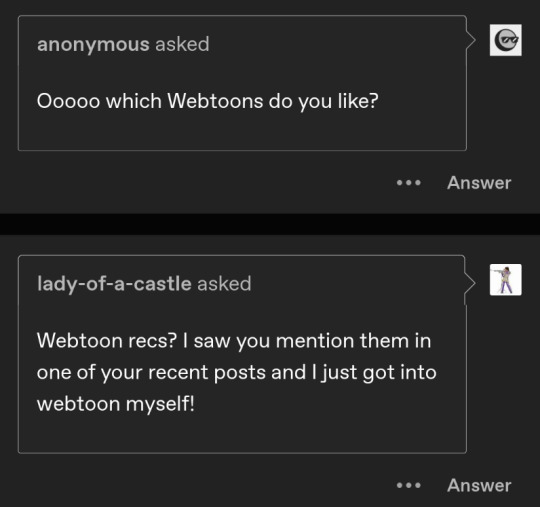

i am here to answer folks 😎
all of these webtoons can be found on webtoons.com! I'm not sure about the whole daily pass thing they've got going on (which sucks tbh) but like,,, you could probably find it online illegally. NOT THAT I CONDONE ILLEGAL ACTIVITY HAHAHAHA ᵖˢˢᵗ ⁱᶠ ʸᵒᵘ ˡᵒᵒᵏ ⁱᵗ'ˢ ᵗʰᵉʳᵉ
I'll split these up between completed and in progress :) most are still in progress though
COMPLETED
1) Gourmet Hound (166 chapters)
this is like, my all time favorite webtoon. it follows Lucy and her quest to find all the chefs that left her favorite restaurant, Dimanche! it’s a really heartfelt story and the food illustrations make you really hungry, so make sure you have a snack before you sit down to read it. each character’s name is also food-related, so that’s pretty cool too! and the diversity in this webtoon is AMAZING. it’s the only webtoon i’ve ever read that has a hijabi character in the main cast. the development is done really well and it explores themes of loving and letting go. all in all, it has a bit of everything. i personally love food-related things, and this centers around it, so i was set LOL
(also a bonus is that this webtoon has NOT succumbed to daily pass hell, so you can binge read the whole thing. legally.)
2) Hooky (200 chapters)
if you like stories of witches, this is the one! the summary and beginning chapters are deceptively lighthearted. DO NOT BE FOOLED! the story really develops further on and explores numerous conflicts, a big one being (if i remember correctly) witch vs. nonwitch. if you like to see struggles between two sides, not a good-and-evil but just people-who-want-the-best-for-themselves-and-their-loved-ones type of thing, this is good for that. also, sibling love! the two main characters are Dani and Dorian, and while there is someee romance, i like how this story centers around the siblings first and foremost. ALSO THE ART??? I LOVE HOW THE AUTHOR DRAWS SETTINGS SO MUCH and am unabashedly jealous because i am completely incapable of doing so just like,,,, even if the story doesn’t pull you in, you can at least stare at each panel for long stretches of time.
(unfortunately succumbed to daily pass, but you can read it on mangaowl or manganelo!)
3) Spirit Fingers (167 chapters)
aww, this one is cute. Amy is 18 and lacking in self confidence (her family definitely doesn’t help). but HEY she joins a wacky art club!! without her parents knowing!! HECK YEAH!! unfortunately it takes more than joining an art club for her to learn to love herself (it is a long journey after all!). i love this webtoon because it explores the problems of multiple people, not just amy: her high achieving brothers, her mother who had to give up her dream, the different members in the art club, Amy’s girl friends. the art is unique and has a cool watercolor-y texture! and the main couple is just adorable, too. if you’re an artist especially, i recommend this because that’s a big theme and you get to see these characters expand their art styles! which is very cool!
(you can read this one fully on 1stkissmanga)
now here’s where the majority of my recs are:
IN PROGRESS (all can be read on webtoon.com)
1) The Makeup Remover (currently 71 chapters)
i look forward to this every tuesday and friday because oh man!!!!!!!!! idk about you guys, but i am thinking about beauty standards A Large Amount of the time, especially when i consume media. and this webtoon is all about beauty standards (specifically in Korea, but still applicable like. everywhere). Main character Yeseul ends up having to partake in this beauty competition and, with her experiences through it, she begins seeing makeup and beauty standards for the huge role they play in society. i said it already but i LOVE LOVE LOVE this webtoon because it really challenges you as a reader to think about your own perspectives. why do we find the things/people beautiful that we do? what shapes our perception? how much of it is marketing, and how much of it shows in our daily lives? what assumptions do you make about people based on how they look? AGHH im sounding like an essay prompt instead of a reviewer but man. if you like webtoons that examine society through a critical lens (gosh i sound like an english teacher), this is the one.
2) Odd Girl out (currently 261 chapters; on season 2)
okay, first and foremost: if you’re NOT into long winded drama, this probably isn’t it for you. i will admit im not a fan of long problems that get dragged out, especially in a school setting, but i did keep reading this webtoon and i am glad that i did! the character development here is amazing and ONE CRUCIAL THING is that the whole first season (which is many, many chapters. at least over 100) focuses on the friendship between our main 4 girls. if you don’t wanna wait for a romance storyline (which comes in season 2), then you’ve gotta have the patience of a saint. i loved this though because lots of romance webtoons cast friendships aside or use them to further the romantic plot. platonic relationships are great to read about and this one does it masterfully! main character nari is resilient and emotionally strong, and it’s great to see her ruin her enemies
3) Cursed Princess Club (currently 110 chapters; on break before the final season)
this is another one about beauty and societal expectations, but in a fantasy setting! it’s really funny and the cast of characters is heartwarming. Gwen is a princess, but she doesn’t look like the typical princess. she accidentally stumbles upon the Cursed Princess Club, which is exactly what it sounds like: a club for princesses that have been cursed and are trying to find their self worth despite not being conventional princesses! now that i think about it, this is like a lighthearted mixture of Makeup Remover and Spirit Fingers. although while i do say “lighthearted”, this webtoon has its fair share of mysteries and exploration of deeper topics. but its funny throughout
4) Brass & Sass (currently 83 chapters)
ahh this one is really cute and the art is cute, too! i also like how this has a diverse cast. high schooler Camilla kinda sucks at band, but dangit if she’s not passionate. Victor is some type of musical prodigy but he’s a brass-hole (hahaha get it. no that’s not original i ripped it from the summary). now i KNOW I KNOW, the whole “perky girl and asshole guy” is so overplayed BUT DON’T FRET! this isn’t the type of story where the girl “fixes” the guy, or where the guy is an asshole to everyone except the girl. believe me, the character development and relationship development in this story is SPLENDID. there’s no real antagonist. it’s just a bunch of high schoolers trying their best to make themselves and everyone else happy, and that’s hard! the story is carried more by the characters than by the plot, but it works well in this case since the characters are strong and each one has a presence.
5) Surviving Romance (currently 10 chapters)
this one is relatively new compared to my other recs but it’s by the author of the Makeup Remover so yaknow i had to hop on it. BUT IT IS VERY DIFFERENT! first off, it’s a horror, so keep that in mind. the best way i can describe it is a mixture of the standard “girl falls into a story” genre, Groundhog Day, and zombies. Yeah. Bascially, Chaerin is our main girl and she’s in a romance story that’s she’s read a bajillion times, so she knows the day has come for her male lead to confess his love! except he doesn’t! because he becomes a zombie instead! hahaha well that sucks! it’s only got 10 chapters but i am very into it, and it seems to be taking an emphasis on platonic relationships, so i am very closely watching 👁👁
6) The Witch and the Bull (currently 60 chapters)
another witch story! and the art is GORGEOUS. more witch + nonwitch conflict, too! our main dude, Tan, is the royal advisor and he’s hella bigoted against witches. our main girl, Aro, happens to be a witch. and Tan needs her help to make him into a human again (because he got turned into a bull. that is worth mentioning). this is a very barebones summary and there’s a lot more that goes on, but that’s the general gist of the beginning!
ANYWAYS. this got very long, predictably, and i rambled for each title, predictably. i’ve got more that i’m reading, but i really like these 9! i also made comments on the art for a lot of them, which might not matter to some people, but i feel like my art was very impacted by each webtoon i read. if you’re an artist i recommend finding a webtoon you like and studying the art; try implementing parts you like into your own style!
anyways, i am FINALLY done talking. bye yall
136 notes
·
View notes
Text
BRF Reading, 22/9/2021
The cards were drawn yesterday (21/9) evening my time, around 11 pm.
This is a request by an Anon, and as current circumstances stand, it's very likely that what my cards see here will not be proved true or untrue until the next century. At this point, I'd consider this more of speculation instead of proper reading.
As written, this is merely a speculation and therefore must be taken with a grain of salt. This speculation is not true until proven otherwise.
My question is, tell me what I need to know about the late Duke of Edinburgh's will.
Cards drawn: Seven of Swords, Knight of Wands, King of Pentacles, Strength, Five of Wands
Underlying energy: Justice
Remarks/Comments: The only definitive "this is a person" energy I get is from the King of Pentacles. My cards seem keen on letting me know about the circumstances surrounding the will instead of the content of the will, much less about the people mentioned in the will despite the presence of court cards.
Summary: There is an urgent swiftness within this spread, which may indicate that his will is to be executed as soon as possible, or perhaps his will is being executed at this very moment. The only person I can see from this reading that is mentioned in his will is HMTQ, suggesting that Philip might have named her the executor of his will, and more importantly, that he perhaps left something behind for her.
First card: Seven of Swords. This is the card of hiding something, diplomacy, tact, secrets, and hidden motivation. This card speaks about how the Duke of Edinburgh wanted his will executed: diplomatically, tactfully, and secretly, which manifested in the statement that his will is to be kept private until the next century. This card seems to suggest that some people will perhaps feel betrayed with the execution of his will; perhaps some people will feel that Philip would leave them something for them to inherit, but when the will is executed, they get nothing.
There is an element of sneakiness to this card, so I think that some people will be caught off guard with the execution of his will. There will perhaps be some people who don't expect anything but then Philip said in his will to leave them something, and there will perhaps be people who are expecting to get something from him but turned out not to get anything.
Second card: Knight of Wands. He is the quickest and fastest-moving of all Knights, he is dynamic, he is quick on his feet. He speaks about action, excitement, acceleration, movement, and new ideas, a herald of things that will be in motion soon. Traditionally, he represents a Sagittarius person, but in this reading, this card comes across not as a person, but rather an attitude.
This card seems to suggest that his will is to be executed swiftly and as soon as possible; in fact, perhaps his will is already being executed at this very moment. In my deck, this card is heavily illustrated with bird motifs (feathers on the knight, the horse looking as if it is about to take flight), further elaborating on its association with the air element and the swiftness of this card. This card also carries with it impulsiveness and a disregard for rules that can get us into trouble down the line, so this card seems to suggest that the way Philip wished his will to be executed might rub some people the wrong way -- but not necessarily a bad way. We have to remember that the late Duke of Edinburgh was an innovator, he was practical and realistic, he had many, many ideas in his head that had rubbed many old-fashioned courtiers in the previous 60-70 years or so the wrong way. He was a modernising drive inside an institution that changed relatively little for its centuries of existence, and that means he would go against the rules so many times.
Third card: King of Pentacles. This is the card of a Taurus person, and in this reading, this card stands for Her Majesty. This seems to suggest that Philip wished for HM to be the executor of his will and that more importantly, there is something in his will relating to her. The King of Pentacles also speaks about wisdom, accomplishment, authority, and creativity, so this card seems to suggest that Philip was wise in how he decided the details of his will: the executor, what is to be shown, what is to be kept private, etc etc. This also drives home that Philip authored his own will, so the authenticity of the will should not be questioned.
Fourth card: Strength. One of the two major arcana cards in this reading, this card speaks about the inner strength to do what is right, the inner fortitude, and the power of the human spirit to overcome any obstacle. This card has always been a theme in Philip's life: his inner strength and his inner fortitude have led him throughout his life. This card also speaks about love, and this suggests that Philip wrote his will for the people he loved the most in this world. He perhaps made sure that for those people, they each get a piece of him, be it from his personal possession or something else.
Fifth card: Five of Wands. This card is about conflict, rivalry, tension, and bickering. This card indicates an internal struggle, which ties in with the Seven of Swords: Philip perhaps had realised that there will be bickering among the family once his will is executed because there will be people who think they should get something from him and those people will create division and tension.
Underlying energy: Justice. This is the card of justice itself, karmic law, honesty, fairness, balance, and reason. This card represents the effects of our actions and the consequences of our decisions. This card is impartial, a symbol of victory, and demonstrates the logical, well-ordered mindset required to make fair decisions. This card suggests that Philip's will is fair and that he tried his best to make sure everyone involved and named in the will to benefit from it. He is fair in who he includes or excludes in his will, he is fair in his decision on who gets what.
Conclusion: As this reading will not be proven true in the next 90 years or so barring any major changes, this reading is at best a speculation because there is no way to prove or disprove what I have seen and I (and most of us) will likely not be alive to see this being proven or disproven.
36 notes
·
View notes
Note
Can I ask what's wrong with Michael W Ford's books? I never read them but I've seen often people recommending them, so I'm curious. Thank you and have a nice day.
Thanks for the question! Sorry if this gets a little long, TL;DR is at the bottom but I've broken down some more specific examples in point form.
I'll preface this by saying that if people get something worthwhile from Michael W Ford's books, that's their business and I'm happy for them. However, there's a few things about his writing and him as a person that I don't really love and struggle to get behind. Most of the specific textual examples I give are from the Bible of the Adversary specifically, as it's one of his more famous books and the only one I personally have had the mental fortitude to page through so far.
- I'm immediately leery of anyone who's often described as a "visionary" or "luminary" on websites selling or listing their books, especially when I've gotten the feeling that it's just that his books are accessible and plentiful. Even among fans of authors like E. A. "Become A Living God" Koetting, the general opinion seems to be that his books lack a lot of consistency and are a bit poorly written. Can confirm for the Bible of the Adversary, at least. There's some parts of that thing that could have used a once-over by an editor.
- I try very hard not to use what happened to the Greater Church of Lucifer/GCoL against him. Another member of the community that I do still (loosely, infrequently) interact with was also involved, and while I sincerely wish they'd both more deeply researched the man they were signing up to run a very public and scrutinized church with, I think his turning into a scam artist who publicly converted to Christianity was enough punishment there. Likewise, I'm a bit uncomfortable with his past involvement with the Order of Nine Angels/ONA/O9A given the fact that they're a pack of murder advocating nazis, but apparently he left when he discovered that fact, so I try to give him the benefit of the doubt that he truly did distance himself from them immediately upon learning of their beliefs, as I don't know when these things became more widely known. However, both of these fumbles alongside how he presents himself and his books just don't sit well with me, as the most generous interpretation is that he was twice-misled in some pretty dangerous and harmful ways by those that are damaging to the public perception of Luciferianism, but still likes to be some figurehead of the Luciferian community. People make mistakes, and people can be misled, and people can learn from past experiences, but his track record is a bit upsetting for a supposed authority.
- His work includes pieces and ideas from occultists or practices that I tend to avoid in my own practice and study, such as Thelema and Crowley's writing as a whole, inspiration taken from the Temple of Set/Setian magic, Qlipoth (because it wouldn't be a Luciferian grimoire without pilfered Jewish mysticism), and forms of Gnosticism that embrace the idea of God as an evil demiurge (which i explained my discomfort with in my previous post). I'm also not a huge fan of his "all magic comes from within" approach (and find it hard to reconcile with his frequent use of Luciferian deities/spirits and demons), nor that he'll talk about Cain's role in "Luciferian grimoires" without actually naming any... though given how similar a piece of Lilith themed artwork he's done looks to Andrew Chumbley's illustration, I assume he means the sort of books the Cultus Sabbati was writing. I wish I still had the Ford version saved or could remember which of his books it's from, the side by side comparison is painful but without it I risk looking like I'm making things up.
- Heavy, heavy use of Lilith, which I don't love for reasons I outlined before. She mostly seems to appear whenever spooky lustful sex magick is being discussed, which is great, that's great.
- He also uses the Wiccan wheel of the year sprinkled in among his more Luciferian focused holy days, which is just really funny to me. Why are we celebrating Beltane, Michael? Why are we celebrating Imbolg? (Page 69)
- He likes to use a lot of "black magic" and "vampyre magic" stuff which tends to feel very sensationalized and over the top to me. I've seen discussions of vampiric magic I found very interesting, but so far his hasn't been one of them.
- He sometimes seems to conflate Lucifer with Samael which I really truly dislike, though it's admittedly not the most baffling or out of left field take I've seen.
- Ford at times seems to either willfully misrepresent or misunderstand information he's passing along. For example, in the Bible of the Adversary he says that Cain's name comes from "...root ‘Kanah’ which means to possess. This by itself presents the antinomian nature of his essence, while instead of sacrificing his most bountiful items to the Lord, he kept them for himself." As I understand it, discussion surrounding Cain's name possibly coming from the Hebrew word קנה (kana) lean more into it being the word for to get or to obtain, referencing Eve's declaration after his conception that she'd gotten a man from the Lord. I'm all for alternate interpretations, but it feels like needless edgy-fying to fit the narrative he's trying to present. (Quote from Page 58)
- He'll say some absolutely bonkers shit like "Abel in some Luciferian Lore is considered a lower pre-form of Cain, thus the sacrifice was not literal" with zero citations or references. Like sir what the fuck does that mean, what Lore, please give us the lore please. (Footnote, Page 59)
- His interpretation of the Watchers and the Book of Enoch is so insultingly bad that I won't even relay it here, but if I see one more person claim that an angel, demon, or spirit they want to distance from Christianity or Judaism is actually a Babylonian god I'm going to go feral.
- As I've hinted at above, it feels like he'll just cherry pick and regurgitate for no real purpose. A few spirits from other texts like the Lesser Key and the Grimoire Verum get mentioned for... mostly the set of names, it seems like, he just kind of lists them out of context.
TL;DR, Michael W Ford feels (to me at least) like someone who has picked out the more appealing and edgy occult trivia and magic he could find from a wide range of sources, recontextualized the parts that didn't appeal to him until they fit his aesthetic and purposes, and presented them as a workable entry point to the Luciferian religion and its potential magical systems that is all flash no substance... and then could barely polish the flash. I don't like that he's many people's first exposure to the concept of theistic Luciferianism, and I don't like how authoritatively he presents his jumbled works as what the religion is truly about when it's so broad a label. Again, if there is something that someone finds useful within his books I am very happy for them, but I have struggled to find anything I could point to that make them worth the read... even for me to investigate further keep critiquing.
I honestly do not know why so people recommend them, unless it's just that they're easy to buy, reasonably inexpensive, and specifically have the Luciferian label on them. If that's truly the case, those people are being lazy and uncritical in a way that doesn't speak well to their apparent Luciferian ideals.
47 notes
·
View notes
Text
Life without the Will to Life: Zeke’s Epiphany
Restless struggling and suffering for the sake of an impossible goal: in a sentence, that is how the philosopher Arthur Schopenhauer saw life. Despite the inevitability of death, we are enslaved by an instinctual compulsion to preserve ourselves.

This compulsion, the Will to Life, is the characteristic that defines life itself.
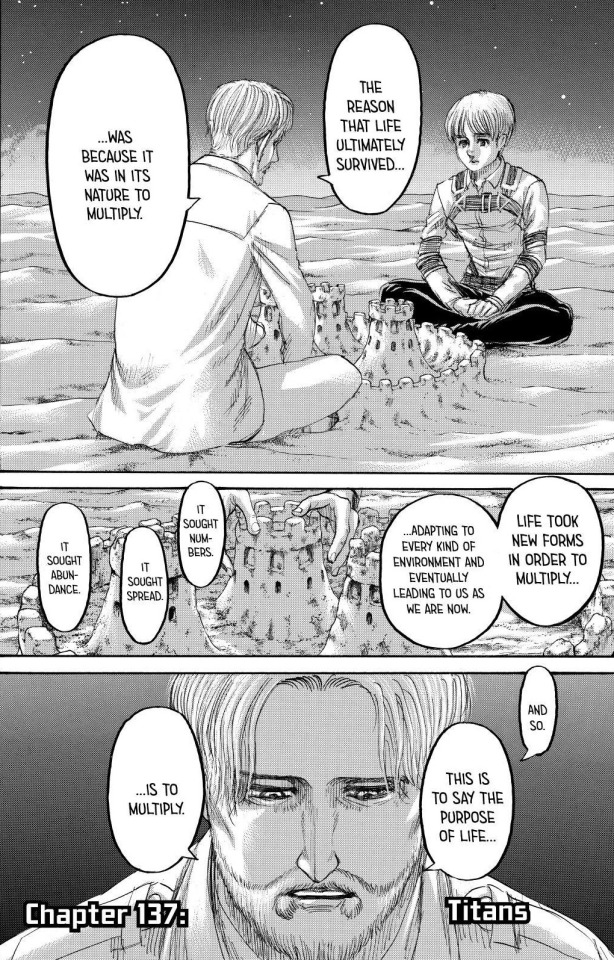
The Will to Life manifests in many forms, not only in struggling to survive. Any attempt to improve the comfort of our existence is a manifestation of the Will to Life. That is to say, all human striving is a naïve denial of the reality of death.
And when the fundamental drive of our existence is that irrational, we cannot be free to make rational choices regarding how we live our lives in spite of death. Instead, the Will to Life forces us to live like tortured prisoners, suffering pain and inflicting pain on others all for the sake of fulfilling that Will which can never truly be satisfied.
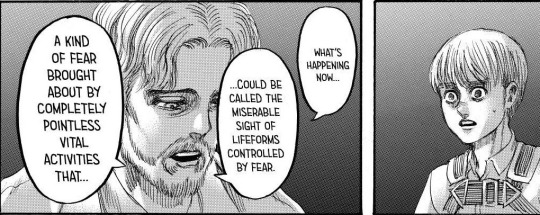
We are like addicts putting ourselves and our loved ones in danger for the sake of our next fix - and it will never be our last one. So long as we satisfy the urge, the addiction will never go away.
Evidently, Zeke is in agreement.
About a year ago now I wrote a two-part series on Schopenhauen themes in SNK. Back then I wasn’t sure how much of the correlation was a co-incidence, but Zeke’s philosophising this chapter has convinced me of Isayama’s familiarity with Schopenhauen thought.
Multiplying is the means by which life survives, and therefore a function of its Will to Life. With that in mind, if you replace ‘in order to multiply’ with ‘in order to fulfil its Will to Life’, Zeke expounds Schopenhauer’s philosophy almost word-for-word: the Will to Life is the fundamental aspect of existence, it is pointless in the long run, and it condemns people to unnecessary suffering.

The intricate sandcastle Zeke builds while describing the Will to Life illustrates the concept further. No matter how much effort is put into building a sandcastle, the nature of the material it is built with means it will inevitably crumble away. Likewise, no matter how life struggles to survive - whether that be an individual, a nation, or a species - it cannot overcome its fundamentally finite nature.
The only lifeform that has managed that impossible feat is Ymir Fritz: the tantalising goal of the Will to Life, which is always forever beyond reach, was reached by Ymir through a miracle.
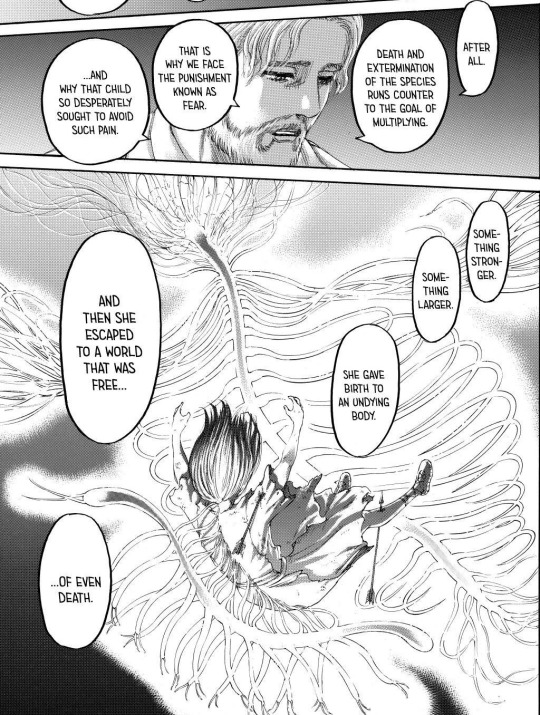
The power of the Nine Titans made it possible. Now living in a world where death does not exist, she should no longer be enslaved by the compulsion to live. She should be the only human who is able to find true peace and happiness within life rather than outside it.
But instead, she continued to involve herself in the affairs of the mortal world, taking orders from the royal bloodline and, eventually, turning on them to help Eren destroy the world. Zeke is immensely confused by this.
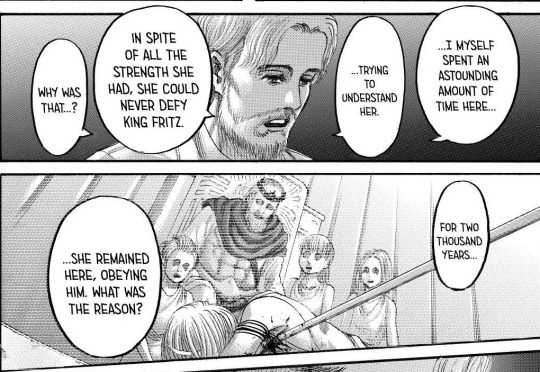
Where Ymir could find peace and tranquillity, instead she continues to struggle, strive, and suffer. She continues to subject herself to the Will to Life because, although she cannot die, she remains deeply involved with a world of people who will inevitably die. The goals that Ymir helps them with are ultimately pointless, destined to fade away to dust - and Ymir knows that. So Zeke is confused as to why she did not simply reach out and take the freedom from it all in front of her.

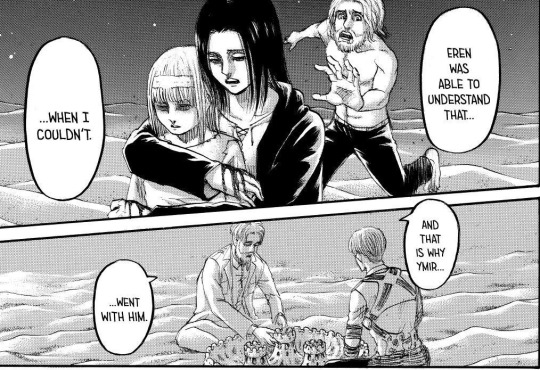
This is why Zeke chose not to help stop the Rumbling. Engaging with the mortal realm at all would be to continue to enslave himself to his arch-enemy, the Will to Life, just like Ymir did. Now he is in this deathless realm, he demands that he at last has the satisfaction of being free of that Will, and so chooses to do nothing.
The situation Zeke found himself in would be Schopenhauer’s ideal: life without the Will to Life. Only, Zeke is hardly blissful in this state. Despite his determination not to be like Ymir, he too is still enslaved to the Will to Life. Rather than rejoicing at his freedom from it, his thoughts are grounded in the mortal realm, lamenting its enslavement by the Will to Life. He remains attached like Ymir is.
It would seem that humans are just too used to living with the Will to Life to be free of it, even when deathless; perhaps this is why, despite vocally rejecting the Will to Life, in practice Zeke preserves his life by staying in the Path Dimension. Even Ymir’s miracle is not enough to liberate humanity of the Will to Life.
So what is there left to do? Die, or never be born in the first place.
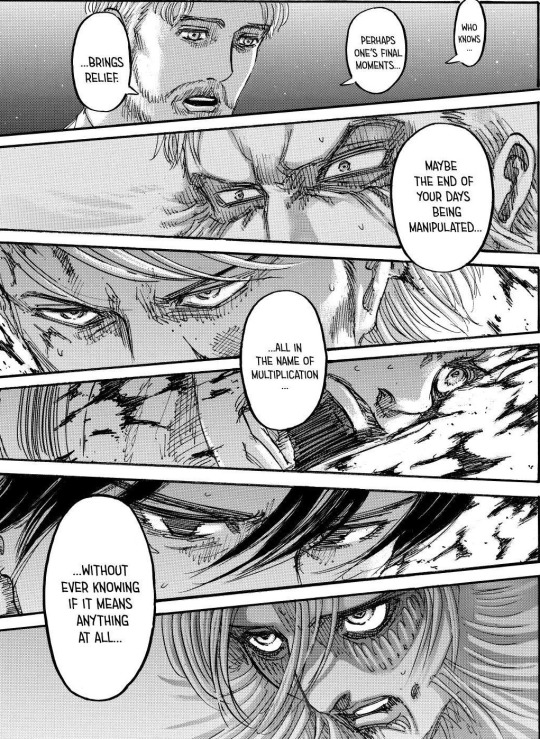
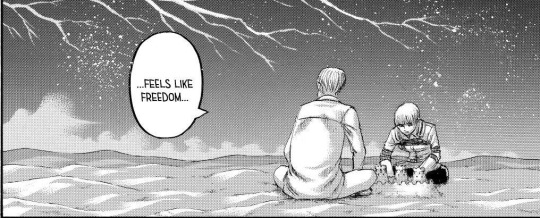
Zeke’s plan for euthanasia was the inevitable end-point of Schopenhauen philosophy.
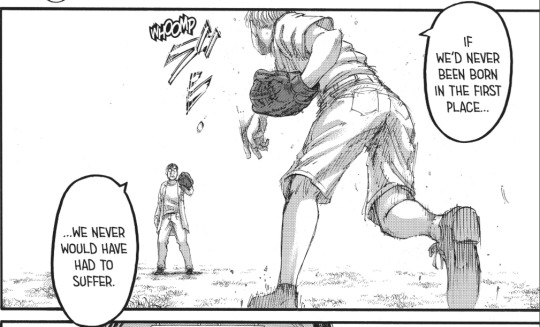
As part of his crusade against the Will to Life, Zeke believes it would be kinder to remain in the Path Dimension and allow humanity to be wiped out. It is the only means of freeing them from the tyranny of the Will.

With this logic, one wonders why Zeke and Schopenhauer did not simply kill themselves. Why live when living can only mean suffering?
Schopenhauer’s justification for life was that there are small avenues within it through which one can escape the Will to Life - where one, for the briefest of precious moments, could appreciate existence without restlessly striving after something. Tranquillity, presence in the moment, peace of mind - for Schopenhauer, these are the things which redeem existence.
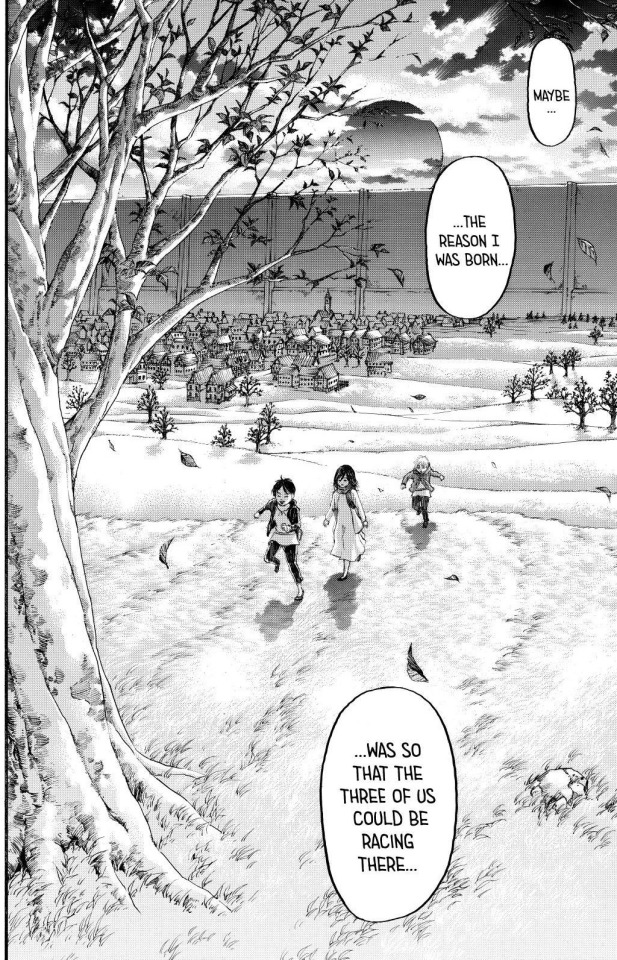
And this is exactly Armin’s counter-argument to Zeke. He argues that these things are beautiful precisely because they have nothing to do with the urge to multiply - that is, they are free from the Will to Life.

Those moments are freedom for Armin and Zeke - being able to appreciate the moment without finding fault or desiring anything beyond it. Zeke is able to appreciate the fact of his birth purely because of those moments playing catch with Mr Xaver, where he was free from the compulsion to restlessly strive.

Zeke sees the pinnacle of his life not in the enactment of his euthanasia plan, but in playing catch.
This is because the euthanasia plan, though intending to liberate Eldians from the Will to Life, was itself a form of restless striving and so an expression of that very same Will. Likewise, his depression in the Path Dimension was because his mind was still fixated on the tragedy of the Will to Life. The only way to be free of the Will to Life is not to understand its true nature, but to forget about it entirely.
Zeke has had to restlessly strive ever since he was a child, with the enormous expectations placed upon him by his parents; so those moments of playing catch and not having to think about anything else were beautiful to Zeke. That’s why he took the time to play catch with Colt, just like Xaver did for him.
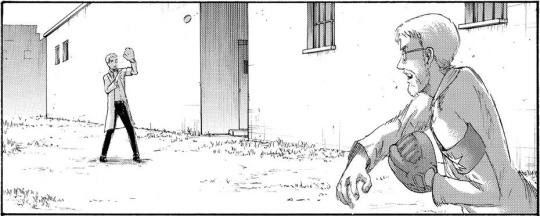
Zeke comes to the conclusion that those simple moments of satisfaction were brilliant enough to justify all the suffering of striving that exists elsewhere in life. Something finally justifies his birth, and so he thanks his father for the gift he once hated him for.

It is telling, though, that Zeke does not renounce the worth of his euthanasia plan. This is because Armin argues with Zeke within the frame of his Schopenhauen ideology. He does not try to convince Zeke that the Will to Life is desirable after all; he appeals to Zeke to value life precisely because it provides moments where one can reject the Will to Life. Thus Zeke can appreciate his own existence while still believing that there is nothing heinous in preventing further manifestations of the Will to Life: in both situations, the Will to Life is opposed.
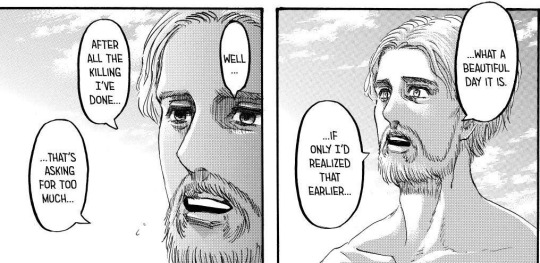
So Zeke dies in truer accordance with the same ideology he has always lived by. In all his restless striving to end the need for restless striving, Zeke never took a moment to appreciate the beauty that exists in those small moments free of that urge. Like his brother, he had been so focused on destroying his enemy that he was unable to appreciate what he was trying to protect.
And so, in a final rejection of the Will to Life, he leaves behind immortality, the ultimate longing of that Will, to embrace death within the realm of the mortal. He calls over the person he knows wants to kill him more than any other.
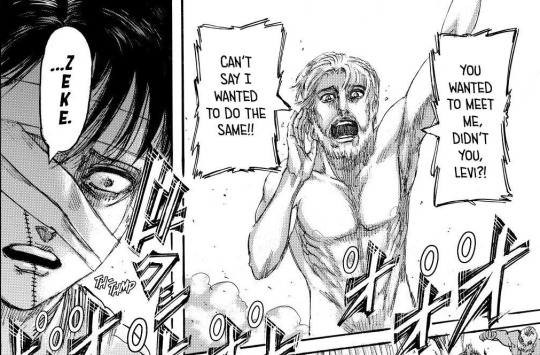
Zeke’s yell of “Can’t say I wanted to do the same!!” reveals that he does not want to die. The Will to Life is still strong in him, but Zeke overcomes it and allows Levi to kill him in the hope that countless lives will be saved - lives that, for the sake of those brief windows free from the Will to Life, are now worth something to him. So where once he claimed he was saving his victims from the Will to Life, he finally regrets "all the killing” he has done.
By Schopenhauer’s definition, Zeke finally found his freedom. Ironically, he could only face his death when he had once again found meaning in life.
#shingeki no kyojin#snk meta#snk 137#zeke jaeger#armin arlert#arthur schopenhauer#difficult concept but i hope i've been able to communicate it
176 notes
·
View notes
Text
the boys and their royal arms
I’ve rambled about this a little bit before on twitter, but I decided to finally sit down and get these thoughts out about noct, his boys, and the royal arms they use!
tldr, the royal arms prompto, gladio, and ignis use during the armiger chain (in addition to the talismans they can get and the boons the kings’ sigils represent in comrades) illustrate key aspects of their characters.
Introduction
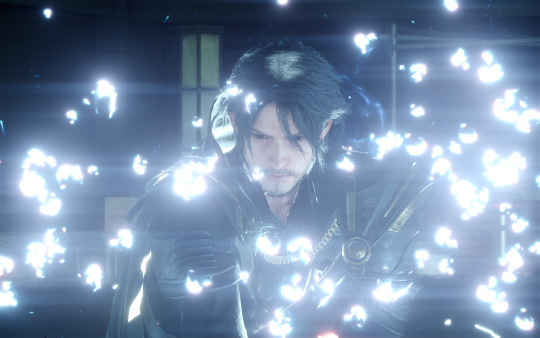
Throughout Final Fantasy XV, Noctis and his retinue search for the Royal Arms, the weapons of the Kings of Yore. They're representative of Noct's birthright and his destiny as the True King. He and his companions, Prompto, Gladio, and Ignis, search for the weapons all over the world. As he adds them to his Armiger, not only does Noctis use the Royal Arms, but the boys wield them as well -- notably, in the Armiger Chain combination attack. Accumulating more of the glaives makes the chain last longer, and all four boys use every weapon in the collection together.
Beyond the battle mechanic, the Royal Arms each of them use carry a strong thematic element. Each glaive illustrates something about each young man -- their characters, their strengths, their weaknesses, their character arcs. This idea extends beyond just the Arms to the Kings themselves, present in their sigils in the Comrades expansion as well as the unique equippable talismans each boy receives.* These themes perfectly illustrate just how connected Prompto, Gladio, and Ignis are to Noctis -- they are fundamentally linked, inexorably bound together.
* (These are only present in the Royal Pack/Royal Edition. They are found in Insomnia in Chapter 14, either after completing all the Kingsglaive quests for Cor. I think. I don't remember... shhsdugif)
Prompto
"My whole life, all I ever wanted was friends... but no one ever wanted me back. So when I finally found people who did want me, I did everything I could to make them stay. And ever since then, I've lived my life in fear -- that one day, they'd find out who I really was, and they wouldn't want me anymore."

Prompto struggles greatly with self-doubt and rejection. He knows he's an outsider and feels that outsiderness to his core, even as a child. But in the face of that, he strives to play the mood maker -- he tries to hold the party together, keep the air light, and make people happy. He attempts to remain outgoing and cheerful, even when he's not, or nobody else is. Noctis and the others love him dearly, regardless of his origins, because he is who he is -- sweet, caring, talented, heartful, thoughtful Prompto. While he at once represents rejection and outsiderness, he also stands for unity and togetherness, and these elements are present in his connection to the Kings.
Prompto receives the talisman of the Clever. The talismans accentuate the boy's unique abilities, and Prompto's grants him increased critical hit rate and unlimited ammo for the SMG. Prompto's gunplay is incredible -- acrobatic, precise, and powerful. It's a far cry from how Prompto tends to feel about himself; he is skilled and capable, even if he doesn't believe he is. The Clever is the perfect mantle for him to carry to represent this.
Though Prompto doesn't use the Bow of the Clever in battle, the Clever fits him very well. The Clever is said to have been a king "versed in myriad arts both martial and intellectual." The Clever's weapon easily fits Prompto, but during the Armiger Chain, it's Noctis who uses it -- while Prompto wields the Sword of the Wise, which carries its own significance.
Noct uses the Bow of the Clever, it fits Prompto as a weapon: it's the only glaive that's projectile, aside from the Star of the Rogue, which Prompto also uses. It fires spectral arrows to skewer foes all across the battlefield. In addition, in the Comrades expansion, the Clever's sigil allows the bearer to summon spectral arms at will. It replaces the use of spells to summon eight special armaments to wield at once. It's a form of battle very appropriate to Prompto, isn't it?
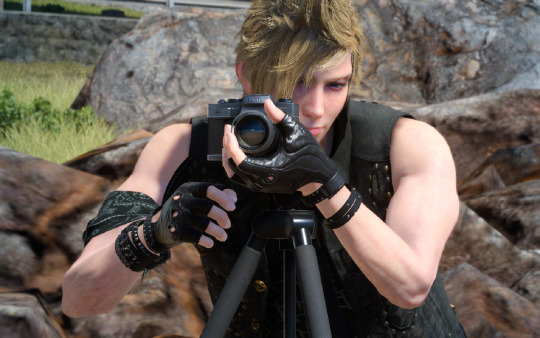
The Clever is said to have been talented in many varied ways. The same could definitely be said of Prompto, whether he believes it or not. While a commoner, he keeps up with his royal companions in battle. When he knocks enemies off guard, he can deliver devastating blows to rival even magic. He can take photos in battle effortlessly -- something his companions love, except when Noct is being gnawed on by a daemon. But while Prompto sees himself as incapable, a burden to his team, he's well able to keep up with them, and strives to hold the group together. The mantle of the Clever fits him so well in this aspect.
But while Noct uses the Bow during the Chain, Prompto uses the Sword of the Wise. The Wise is the King who first erected the Wall and established the borders of the kingdom of Lucis. He was a notably mighty figure and protected the realm. His blade represents the foundation of the Kingdom, and Noct's birthright -- and while Noct uses the weapon that most fits Prompto, Prompto in turn uses the Sword of the Wise, a clear symbol of Noct's royal blood. He is more than capable and deserving to wield it, even briefly, despite how Prompto feels about himself.
Prompto also uses the Star of the Rogue. The Rogue was a figure reviled by the people. She "spurned the public eye and took to the shadows." It's a huge shuriken, and Prompto actually briefly wields it against the daemonified Rogue in the Citadel battle. The Rogue is a figure of royal power but rejection -- intensely shunned by the people, choosing to rule away from their eyes. She wears a mask in her armor; it doesn't appear to be a helmet or battle regalia, but rather a means of hiding her face, obscuring herself further.
The queen is a figure of stealth and prowess, but will never quite belong to the public, to her people. Only when she is gone is she remembered fondly by history. Prompto definitely feels he doesn't belong, and likely that he never will. He's a lonely child from a lonely home. He knows he's from the enemy nation, branded by them. For years, he doesn't believe he deserves to be Noctis's friend, and pushes himself to be good enough to finally approach him. Even when he's assimilated into Noct's retinue, he feels he doesn't compare to the likes of them, and fears the day they all reject him... even though the idea is completely unthinkable to them.
This idea extends nicely to the third Royal Arm Prompto uses, the Scepter of the Pious. The Pious is described as a king who "ruled the realm according to divine law and worked hand in hand with the Oracle." It's a weapon that strikes with a blade of light. It enhances magic and is particularly strong against dark elements. The Scepter is a weapon to represent unity, togetherness. The King worked with the Oracle -- a nice parallel to Prompto's correspondence with Lunafreya, and how she gave him the courage to befriend Noctis -- to unite Lucis. It's a weapon that represents strength in teamwork, in united people, breaking down the walls that divide them to live as one.

Prompto's use of the Royal Arms illustrate his biggest fears and greatest strengths. He's an outsider, terrified of rejection. But he's a dedicated and loyal friend, devoted to helping them and keeping them happy. Despite the differences that could potentially drive them apart, Prompto is a vital part of Noct's retinue. Despite his wavering confidence, he is talented and incredibly skilled. He's unique and irreplaceable, and his closest friends know that. One day, Prompto will, too, and he and Noct can knock down the barriers between their people once and for all.
"I owe Noct everything, for standing by me always. And now... it’s my turn to stand by him.”
Gladio
"I swore a vow to do whatever it takes to protect you and the future of our world."
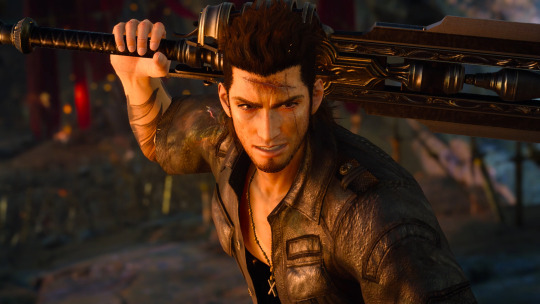
So, let's get this out of the way: Gladio suffers from a tragic lack of character development. While this can be another sad side effect of XV's troubled development **, we can attempt to spin it into something subtle and quiet, illustrating Gladio's softer side. His connection to the Royal Arms shows that not only does he want to be strong, he wants to protect those he cares about above all else. Gladio is ultimately very caring and deeply, truly loyal, even though he's as hard and heavy as blade steel sometimes.
** (Rumor has it, Clarus, Gladio's father, was going to betray the Crown, and Gladio would face deep inner conflict over it, having to choose between his father's ideals and Noctis's journey. Apparently the role was given instead to Drautos/Glauca in Kingsglaive, who has a much more prominent presence in the movie than Clarus. None of this is confirmed, though, and isn't present in any released canon materials... so who knows. It's worth mentioning because it speaks to maybe their taking out Gladio's planned character arc and forgetting to put anything back in its place...here’s the reddit post that compiles the theories pretty well, if you’re curious.)
Gladio receives the Tall's talisman. When it's equipped, it accelerates the rate at which Gladio's valor gauge increases. His valor, in battle, best increases from uninterrupted combos and counterattacks, both appropriate given his nature as Shield, well-trained for battle but focused on defense. It's a simple boon that's incredibly valuable in battle, and battle is an inescapable aspect of Gladio's life. Along with the talisman, Gladio wields the Sword of the Tall. It's a broadsword, Gladio's preferred type of weapon. The Tall is said to have been "built like a mountain, towering over all others." It's a peculiar kind of sword with a chainsaw-like blade, which rips and tears mercilessly through enemies. For its incredible strength and vitality boost, it lowers elemental and magic defenses. This is matched by the Tall's sigil in the Comrades expansion, which greatly increases attack power at the cost of casting spells. The Tall's is a mantle of muscle, not mettle, but it's not the only King's presence Gladio carries.
Gladio also wields the Shield of the Just. His secondary preferred weapon is a shield, obviously focused on defense and counters. The Just is a queen of yore -- she and the Rogue are the only queens of Lucis present ingame. She is not given a name, but her armor has a massive silhouette, her presence immense. The Shield of the Just, as expected, offers Noctis huge defense. It greatly decreases attack to grant significant defenses, both physical and elemental. Its description describes the Just as a queen devoted to peace who was loved by all. Though her phantom visage is imposing, the Just is a strong, steadfast figure of peace, not violence. It's a strong contrast to the Sword of the Tall; if the Tall's is his blade, the Just's is his shield.

The Axe of the Conqueror is the third Royal Arm Gladio uses. While the Tall and the Just represent Gladio's strength and will to protect, the Conqueror represents willpower and moving forward. The Axe describes the Conqueror as a king who "performed great feats of arms, expanded his realm, and made his people prosper." This is all too appropriate for Gladio's role in Noctis's retinue, not just as his protector but his guide. When Noct can't move forward, Gladio pushes him. When he can't think, Gladio thinks for him. When things get difficult, Gladio helps Noctis grow and move on, whether he wants to or not. Gladio is a big brother, after all, and he wants only the best for those he cares about and wants them to succeed, just as the Conqueror did.
Gladio's use of the Royal Arms illustrates his boundless strength both in offense and defense. He carries a broadsword and shield and the needs of his companions. Gladio pushes forward. He is fiercely loyal and cares deeply for those around him, and pushes forward without hesitation, bringing those he must protect with him. Gladio wants to be strong, not only for the sake of power, but for the power to protect the ones he cares about. He cherishes the things he holds dear, and will protect them with all his being.

"You're right, I am afraid. ... Maybe I'm not really cut out for the job I'm expected to do. ... I may be all muscle and no mettle, but I'm gonna keep protecting Noct the only way I know how."
Ignis
"This world means nothing to me. Do with it as you wish. ... But I refuse to let Noct sacrifice his life to save ours. I won't let you take him away."

Ignis has served the Crown for nearly all his life. He's been Noct's companion the whole while -- his friend and brother, as designated by King Regis himself. Since he was a child, he's carried royal responsibility. He's composed, precise, and calculating, well-versed in all kinds of matters, political and not. He's a strategist, a royal advisor, and he keeps at Noct's side without hesitation. While he maintains a very cool, thoughtful demeanor, confronting problems with plans and logic, he has a relentless, reckless side. He is willing to resort to violence should the plan call for it, especially if the safety of Noctis and his companions is at stake. Ignis has a very smooth, calm surface with a deep, deep underlying intensity that rarely shows.
Ignis receives the Wanderer's talisman in the fallen Insomnia. When it's equipped, it boosts Ignis's Total Clarity gauge, heightening his senses and deepening his focus. In battle, Ignis uses strategic elemancy -- imbuing his daggers with fire, ice, and lightning -- and counterattacks. He doesn't utilize raw strength; instead, his battle prowess uses his strategic mind. Reaching Total Clarity allows him to unleash a particularly decisive blow. He is a fast, strategic, relentless attacker, perfectly carrying the mantle of the Wanderer. In addition, the Wanderer's sigil in Comrades carries an entirely supportive effect -- it casts Cheer on the party, heightening their abilities. It fits Ignis's penchant for strategy, supporting his comrades and planning instead of rushing into battle and relying on raw strength.
The Wanderer is said to have been "quick like the wind and went where no man had gone before." His swords "rain fury -- together they deliver thundering blows." The Swords of the Wanderer have three distinct forms, interlinked and not, to adjust to the needs of battle. The Wanderer was clearly a versatile, flexible fighter. He roamed the unknown and pressed on into strange territory without fear. "Wandering" implies a lack of a destination, focusing not on the end of the journey but shoving onward regardless.
It's too fitting that Regis tells a young Ignis something he will never forget: "One cannot lead by standing still. A King pushes onward always, accepting the consequences and never looking back."
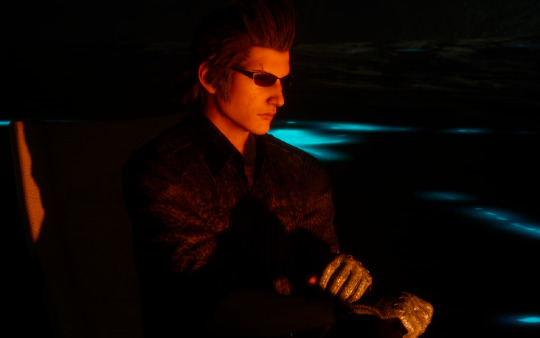
When Ignis is blinded by his sacrifice and Noct disappears into the Crystal, the Wanderer mantle fits him even more. The light has disappeared from his world, both literally and metaphorically. He can no longer see -- greatly debilitating his extensive prowess -- and his life's purpose, being at Noctis's side, is left to the lurch. He investigates the royal tombs and the ruins of old civilizations to the best of his ability. He pushes on alone, not to prove anything to his friends but to himself. He refuses to burden anyone, even though the boys would never think that of him. He's left without a destination, without purpose, but pushes onward, always. He finds the ability to fight again, delves deep into the history of Eos, and holds onto the hope that one day Noctis will return. And, soon enough, he does, only for the prophecy to snatch him away once and for all.
Ignis also wields the Katana of the Warrior, which couldn't be more fitting for him, especially given his relationship with Noct. The glaive is even found in Fondina Castino in Cartanica, the boys' first stop after the catastrophe in Altissia. Ignis is blind, hating himself for every stumble, hating how Gladio and Noct fight while Prompto tries to stop them. After the retinue finds the Katana, Ignis finds his resolve and tells his companions he will continue, and if he can't keep up, he will not hinder them. He will gladly fall behind if it means they can push on together. "I would remain with you all," he says, "to the very end."
The Warrior's glaive bears a tragic description: "A king was changed forever when his beloved queen was taken from him prematurely. This was his katana." The weapon strikes swiftly, calculatedly, cutting down foes “in a single heartbeat." It carries magical defense but is especially weak to dark elements. The Warrior's mantle couples well with Ignis's losses throughout the story -- he loses his home, his sight, the light of the world, and his most beloved companion. Even then, he pushes on. He carries his sorrows and pushes onward, regardless, knowing full well the pain of losing everything that matters, and what else there is to lose.

The third Royal Arm Ignis wields is the Mace of the Fierce. The Fierce was said to be "gentle before his people but an ogre on the battlefield," dealing massive, crippling blows with his glaive. This weapon in particular illustrates the side of Ignis he keeps carefully hidden. For all his composure, his careful planning and strategic mind, he can be reckless, ruthless, and violent. When planning to infiltrate an Empire base, for instance, he's not above torturing someone to get information he needs. When he needs to get something done, he will get it done. When it comes to Noct's safety, he will do whatever it takes. He will gladly throw away his own safety, his sight, and his life to save him. This duality is nicely represented by the Fierce's glaive -- nice and composed, but cold and relentless when the situation calls for it.
Beneath his calm, placid surface, Ignis is a blazing fire. He's intensely driven, fiercely loyal, and wholly devoted to Noctis as he has been his whole life. He will throw everything away without question, even himself, if it means saving the ones he cares about. He is thoughtful and strong, careful and precise, but has a tendency to be ruthless, reckless, and destructive -- forgoing his own wellbeing to reach his ends. In the wake of tragedy, he pushes on, holding onto unwavering hope, unyielding devotion, unable to ever let go.
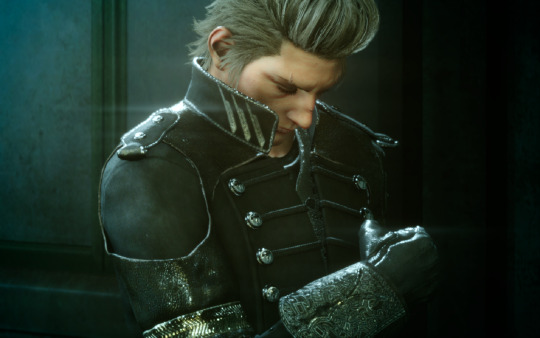
"Even if it costs my own life to save him... I will pay that price!"
All for the True King
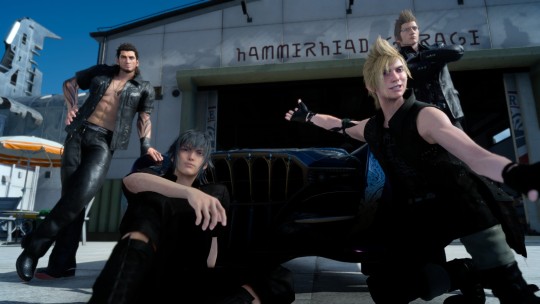
The remaining four Royal Arms are used by Noct in the Armiger Chain. They, too, carry significance in his wielding them -- especially in the combination attack, symbolizing the unity of him and those he cares about. Noctis wields the Blade of the Mystic, the Bow of the Clever, the Trident of the Oracle, and the Sword of the Father during the Armiger Chain. The Blade of the Mystic stands for the Founder King. The Bow of the Clever is a weapon especially fit for Prompto, who then wields the Sword of the Wise, one of the fundamental figures of Lucian history. The Trident of the Oracle belongs to Luna, and the Sword of the Father belongs to none other than King Regis.
Noct's use of the Royal arms in the chain complements those his boys use, further symbolizing the unity and togetherness between them and the people -- and the whole world -- they care about. The Kings' stories are present in the Prince's friends, showing just how deeply connected they are to Noctis. There's no doubt Noct loves his boys dearly, and their thematic connections to the Kings and their weapons only illustrate how much they care about each other. They travel together, ride together, and rule together with the blessings of Kings past. Even in the wake of trial and tragedy, they remain inseparable, inexorably bound together, standing tall in the face of the dawn.
tldr AND DARLING DARLINGGGG STANDDDD MY MEEEE
screenshots from ardynizunya on twitter and the final fantasy fan wiki -- please let me know if you need credit for any of these! ;o;/
#ffxv#final fantasy xv#analysis#words words words#uhhhhh#how do I tag this#royal arms#comrades is okay and I enjoy it sometimes it's a 6/10 maybe play if you like crumbs of lore like me
130 notes
·
View notes
Text
Why Cinder Fall Carries The Thematic Message Of RWBY's Antagonists...
And What That Could Mean For Her Character.
...
Now, from an audience's perspective, I would say that the outcome of RWBY's villains carry the theme of, No matter your past or the moments that lead up to this point, one will eventually come at a crossroads where they decide what they want to be and what they want to do with their life, whether they want to be 'good' or 'bad'. And that, from what we've seen so far regarding our antagonists like Adam, Roman and Clover (more on him later) choosing the 'bad' whatever that might be in their situation, would have devastating consequences.
But first and foremost, they will and have to be given a choice.
Now admitedly these instances where characters are given these choices are either implicit, nuanced or are given in a second with minor characters which are in the majority and shall be addressed first.
...
Given Roman's last confrontation with Ruby, it can be said that he have long since chosen his path and that the consequences of that choice finally arrived. Although CRWBY not able to cast him for future volumes definitely plays a big part in this. So I don't want to place top my h weight on this charater, even if it's worth mentioning.
Of course we have Adam. Now his backstory definitely propels him down his path of spite and destruction, but one would be wrong by saying that other faunus, maybe even Ghira and especially Blake, have not tried their best to help him chose a better way to fight for his cause and work through his past by showing him the possibility of a better life. I mean isn't that part of the reason Blake stayed? Because of the hope that he could change and could be better, going so far as to try to tell herself that he isn't the monster he is becoming? Even Sienna, although her in own skewed way, tried to direct Adam's path. But Adam continuously chooses the path of spite and hate after every fight and altercation with Blake and Yang. Adam has had many chances, the fact that we didn't see what these different choices could amount to, is simply due to the fact that he has already made up his mind, and that, keep in mind, he was still a relatively minor charater compared to the rest. Adam's final crossroads with Blake and Yang approached, and he paid the consequences.
Now we Clover, and as an antagonist in his final scene the same would apply. He had the choice between capturing Qrow or Tyrian. Following orders or doing what is right. I bring this up to illustrate that even what seems to be a simple theme, there are still variations and exceptions, such as the gravity of the choices and consequences, that further reaffirms and explores the theme.
And I adress this theme through minor characters first, because if they are so clearly seen in them, then it's irrefutable that they are present in the main characters. But before we get to the main antagonists, because they do have a lot more complexities attached to them, let's look at the opposite end of the message to make sure it even holds up when explored.
If an antagonist continuously goes down the wrong path it will lead to negative consequences, then choosing the right path, will bring about a happier ending. And for a fandom that seems so caught up with the concept of 'redemption' (in quotation marks because I have a very different view on what that is and should look like, and I don't know if I'll be able to get to it in this post) one would think that RWBY would be rampant with 'redemption' arcs. But we've only seen one redemption throughout the whole show.
...
And that is Illia's arc.
She's interesting in that I see her as a foil to Adam (a post that I'm sure has already been made). Her change at deciding to change and lead a better life as well as the person to support her through this change, is also Blake. And when Illia does decide to do good, we are shown that she is not only happier, but she is working alongside Ghira to bring about the positive change within the White Fang, that she has sought to do for so long. Just like Adam, Illia has experienced incredible trauma because of the SDC, but she chose to not let it define her in the end.
...
Now, enough about these minor characters, let's look at team WTCH.
When we see Tyrian and Watts, and through the snippets of implicit backstory, that they have already chosen Salem against all else and that they are set in that choice. I've brought up antagonists who have already chosen their path like Roman, and they are important because since they are already solidified an antagonist who has no desite to change, they pose a much bigger threat and it adds variation to the theme in how it's presented.
Now Hazel interestingly has been the only one who understands the means of what they are doing and the negative consequences of their actions, but that for him, it is ultimately justified. Even so, Hazel does use force as a last resort. And what was more surprising, was the reveal that Hazel aligned himself with Salem, not because he necessarily believes in what she is doing, but that she is impossible to go against. This most likely makes him feel that there isn't any choice, not with an equal possibility of outcome at least. But Ozpin/Oscar challenges that notion. He tells Hazel that Salem can be fought and he gives him a choice, or at least an option to chose his role in this battle. Because of our track record of antagonists sticking to their initial role in the narrative, it would make sense to deviate from that and give us Hazel who has the possibility of turning to the good side. However, how this plays out has yet to be seen. I do think that he would die in the end. Why? Because the narrative has yet to show how a charater can enact positive change and be better, even if they might not get to see the full extent of their actions. In short, exploration of the theme. Because the theme does not equate choosing the path of 'good' with the promise of living, simply that there will be positive outcome of such a decision but what that looks like will be different depending on the charater. Of course this means that that choosing the path of 'bad' won't necessarily mean death. It could mean being imprisoned (Looking at Ironwood, possibly Mercury) or something lighter that simply means having to move locations often and be on guard (Looking at Neo). These outcomes still fall in line with the show's message regarding villans but because they lie on it's outskirts, I would expect them to be portrayed sparingly at best, as not to risk betraying what has already established but still maintain a sense of 'realism'.
...
Now, I've been talking about how the theme essentially brings about the 'good guys' winning and the 'bad guys' losing, but that could literally be any other piece of media. But like I said in the very beginning, it is only the outcome of the theme, not the theme itself. What makes RWBY's message regarding its antagonists so different, is its emphasis on choice.
And that brings us to the true message.
That bad people can and should be given a chance to be better, to become better people.
This doesn't mean that people would take that road, or that they would want to change, but that they should be given it nonetheless. Some people will get more than once chance, and some of those consequences will be more dire than others. Not everyone can easily become better, but for everyone there will be a possibility, no matter how small.
...
And this brings us to Cinder Fall.
Now, in light of the events in her backstory, some would consider Cinder killing Rhodes instead of surrendering to be her crossroads. After all it I'd what firmly set her in place to seek power in the name of freedom. And if this was shown to us sooner, if Cinder died in volume 3 or 5, I would have agreed… to an extent. If Cinder was a more minor charater, or died in volume 3 or 5, that scene would have been enough content to show and give us an explaination for her choice and it leading to her downfall. As for why only partly agree? Because it wasn't presented as a choice. Killing Rhodes and her abusers weren't a crossroad, but rather a threshold, even if it's one she chose to cross. Because the path presented to her was the only one Cinder believed is available to her. Remember, it's also important to think how these choices are presented to the characters and whether they see them as such. Of course, it's important to remember that Cinder is a main villain, our first villian and the only cillian we've seen struggling to this extent, it makes sense that her story is much more detailed and complex, but there is another reason I will get to later (she is also not the only one whose story has been treated as such, but more on that later.)
So Cinder has been shown to make choies that garders to her current goal of achieving power. But only because she is not presented with another path that gives her the freedom she wants (keep in mind that does does not exuse Cinder's actions or that she shouldn't face the consequences thereof, and trust me, she has faced many). Salem does not give her choices. She gives Cinder a path, a way forward, and consequences should she not take it.
Becoming part of Salem's ranks wasn't her crossroads either. Only, Cinder *thinks* it is. She thinks she has chosen the path to freedom, but she will eventually come to the realisation that this is not it. That there is another way. And the only thing that can show her this.
...
The Relic of Choice.
While Emerald and perhaps Neo will be the ones to support her if she chooses to become a better person, the person she wanted to be, no person could ever convince her that something like that exists. Not after what she has seen in humanity.
But the relic can.
It can show her a future where she does take a different path, and one where she doesn't.
This is Cinder's crossroads. Getting to the Relic is the end goal that has been unknownly set up for Cinder since the beginning. The Relic will most likely be the last thing that stands between humanity's destruction, it represents the height of the final conflict and ties into Cinder's charater specifically. For once it is not something she necessarily wants, but something that she needs. That is why Cinder carries the thematic message around RWBY's villains. Because if it were anyone else, any other relic, any other Maiden, the theme would not hold up. It would be something entirely else.
...
Cinder is at her crossroads.
She has been shown to where each path leads.
What will she choose?
The theme only says that one should be given the option to chose to be good, not that they will or should.
It could go either way.
But I believe Cinder will turn to walk down the path of good.
And here I can hear half of of you groaning. But before we go into why I think so, because again, everything at this point is simply my prediction, let's look at what will happen if Cinder choses power over true freedom.
She will most likely die, of that I have little doubt, or sentenced to life in prison or constant running at the very least. This all runs in accrodance to the theme. A main villian stays on the road of evil despite being shown a better way, and pays dearly for it. Only...RWBY has already done this…
...
With Salem!
As our big bad and one of the main villians and the pure epic that was 'The Lost' fable, we have seen all the prominent moments and choices who made Salem who she is. And at every turn, the death of Ozma, the death and rebirth of the world, Salem has chosen the path of Darkness and not just figuratively either. (And yet, they still managed to make her sympathetic at one point which is a commendable feat). The gods might have been cruel in their punishments, but all things considered, gracious inhow many times they have given her the option to change her ways. Of course Salem's final decision came with the death of Ozma and her children.
Salem might be the big bad, and defeating her is the end goal, her actions dive the basis of the plot and our heroes' actions. As these final moments of her story concedes with Cinder's story, I very much like the idea of the story ending with the defeat of the antagonist who chooses the path of darkness, while one of RWBY's main themes linger in its audience's mind as another antagonist chooses the path of good, a new life. Now I'm getting much to sappy and caught up in these satisfying nuances and touches.
But my main point has been made. Cinder will choose to change, but what could this new life look like? What are the consequences? After all, we've already established that the gravity of the outcome does not concede with the choice even if it it is presented as positive for good and negative for bad.
In short, could Cinder's change be an act of goodness that concedes with her death?
...
It could, but I don't think it will.
While it is true that the death of a charater could carry a positive outcome to others, it does not align with Cinder's goal of freedom, therefore death would be seen as a punishment and contradict the theme itself. And because Cinder is the charater who embodies it, it means that the end of her story should end on a positive note.
This doesn't mean Cinder becoming a better person will be easy, it doesn't mean that she should be forgiven, that she shouldn't face the consequences of her past.
But after everything she went through, after all her struggles and trauma, Cinder would have the life her younger self wanted. The freedom she wanted to choose for herself.
And I think that is a ending we can, and should hope for...
46 notes
·
View notes
Text
Underappreciated themes in OPM. 1: The Curse of Gamification
One-Punch Man is only partially a parody. At times it is a satire, and in the instance of the points-based system the Hero Association uses to manage its heroes, it is a sharp one on the subject of gamification. While treating non-games as games has been around since the 19th century, the 2010s is when it really took off, round about when ONE started writing OPM.
Since then, it’s only become more pervasive: you can set objectives, quests, and get rewards for just about anything. Eating, sleeping, completing in-work induction, delivering packages, you name it, someone has gamified it. It delivers regular little hits of gratification, bigger hits when you rank up, and rivalry when there’s a leaderboard.
The way the Hero Association has implemented it, it’s a straight up gaming system. We got introduced to their game system right at the newcomer's welcome lecture, where Snek explains that misbehaving heroes can lose points and thus rank.

How to win the Hero Association game? Well, obviously, you can gets points for fighting monsters, but that's not the only thing they take into consideration. You can get points for doing good deeds, for being active, all sorts of things. So much so that the manga notes that 'if you keep active and play to your strengths, you can hang onto quite high rankings within a class' using Mumen Rider as a poster boy for a hero who does just that.

The good thing about Mumen Rider is that he doesn't try to stop other heroes from briefly occupying rank C-1 so they have a chance to be promoted
Furthermore, the points the Hero Association awards can be divided between heroes... and the points split gets decided between the heroes themselves. This is where the likes of the Blizzard Group really come into play. However, it goes further than that: since all heroes in a group of heroes get at least some credit for killing a monster, it benefits lower-ranked heroes to hang around a powerful one. That's why the Tank Toppers get so mad at Saitama, they think he's playing the leech off the S-Class game (and doing it better than they are).
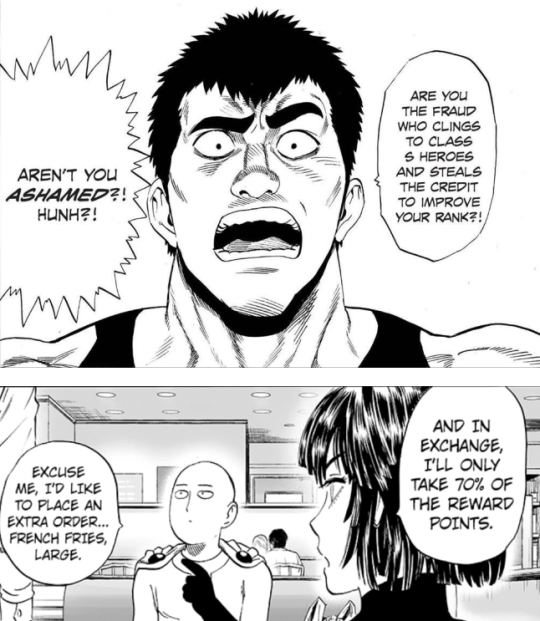
Points-chasing is so much safer than monster-chasing
What's in it for the Hero Association? By their very nature, heroes need to be highly self-directed and self-motivated people: if you don't have the initiative to find trouble and the courage to stand up to it, even if no one else has your back, you have no business being a hero. The points-based system allows heroes to more or less manage themselves, motivate and push themselves with minimal input from the Hero Association. The good side of it for heroes is that they get a lot of freedom as to how they conduct themselves, which allows some real oddballs to thrive.
There are three big problems with the Hero Association game that the story has been showing us.
Problem 0: The game itself is unnecessary. Monsters don't know and don't give a crap about how heroes organize themselves, or whether they're nice or cooperative. They only care about whether or not anyone is able to stop them. Same goes for criminals.
Problem 1: Wherever there is a game, there are people who try to win it strategically. It creates incentives to win points by means other than fighting monsters or criminals too dangerous for the police to handle. A lot of the nonsense we see, like rookie crushing, forming factions, refusing promotions to a higher class since they mean more responsibility and less recognition, chicanery, and going for cheap gimmicks to try to gain points through popularity all stem from the game.
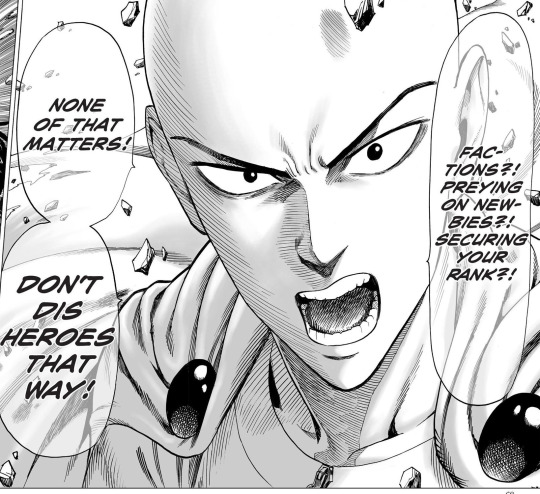
games-playing makes a mockery of heroism
Problem 2: Picking the right fight. The special chapter 'Disaster Levels' makes mention of some heroes pushing themselves to fight high-level monsters, but Season 2's OAV 2 really hones in on that problem. We see Bang and Atomic Samurai discussing the problems with the Hero Association. They single out the Hero Association’s points-based system for especial censure, both being of the opinion that it encourages heroes to take unnecessary risks. And case in point, we see Mumen Rider and Chain n' Toad take on far too much monster for them and need bailing out. It was very good to hear Atomic scold them for relying on guts rather than making sure they also had the strength to back it up.

Taking unnecessary risks may be flashy but it's bad for hero health
Problem 3 (and the biggest one): By its very existence, it turns fellow heroes from colleagues into competitors. The webcomic is really going to town on this issue, but I don't need to go that far to illustrate it.
A system that rewards individualism makes for reluctant team-building. Nurturing leaders? That implies group-formation, so we see very few heroes lead. We see pointless divisions between classes as S-Class heroes get lionized (and over-worked), while good lower-ranking heroes get overlooked. It's a situation made even more pernicious by the Hero Association being perfectly aware that there are many promising lower-ranked heroes who could do with development.

This resentment is completely unnecessary
More seriously, it means that failures can be individualised -- it’s your fault if you’re struggling rather than the system as a whole. If you're competing, it's harder to compare notes to realise that you are all suffering in the same way. Pro-heroes are actually in a very strong bargaining position: despite running Hero Tests year round, for free, in multiple locations, the Hero Association has never succeeded in having more than 600 heroes on its books at any one time. Pro-heroes aren't easily replaced. Things like decent pay, accommodation, help with equipment, and access to training facilities should not be privileges reserved for Class A and S heroes and held out as a carrot for lower-ranked heroes. They should be a matter of course, that would make heroes much more effective. Which is what the public and major donors are paying for.
The concept of the game system with its someone-must-win-someone-must-lose ethos blocks a lot of innovation. Training: they make it a matter of duty for A-Class heroes to orient new recruits, but also having a buddy to look out for new heroes for the first few weeks would be a huge help. Having strong heroes take at least one student to bring on would make a huge difference. And someone like Bang would love it as he's always looking for dojo members. They could get rid of a lot of the infighting by getting rid of ranks within a class and instead having brackets according to how effective heroes are within that class and make it clear that there's no absolute size for any bracket: they'll leave a bracket empty if there's no one deserving of it. Anyone in the top bracket can apply to go to the next class if they can convince the promotion team that they can hack it in the next class up -- no more value in camping the top spot and trying to suppress other heroes. Better data sharing. Pastoral care: it's tough being a hero even if everything's going right, but a competitive system means that heroes hide their woes until they can't stand it any longer and quit. And so on.
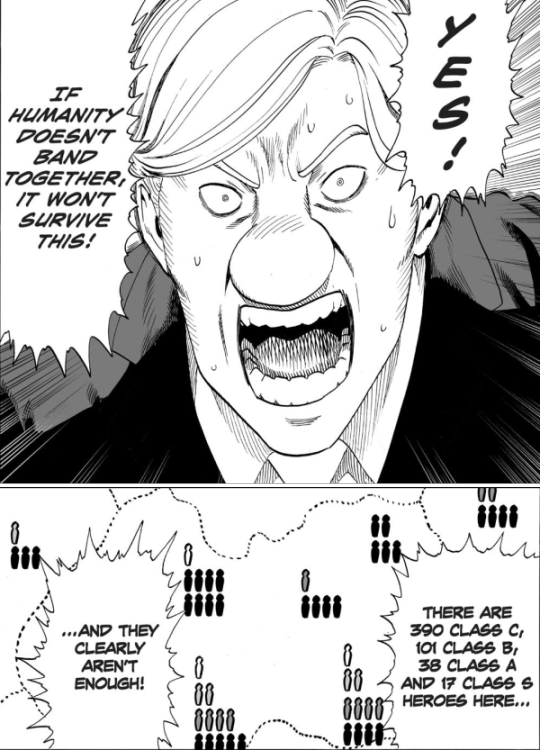
If heroes are so precious, why aren't they being looked after better?
If you're looking for the thesis of this to be that gamification is bad, that's not it. Rather, it's that all things have their appropriate place and when misused, bad things happen. Gamifying running a marathon? Awesome. Be the fastest delivery man in the tri-state area? Knock yourself out. Sales targets? Fantastic! Those are situations games work very well for. Gamifying a hero group, where people should be ready to work together and help fight the increasing and increasingly complex threats that blow up out of nowhere, it's idiocy.
Idiocy the rest of the world is paying for.
54 notes
·
View notes
Text
TGF Thoughts: 5x05-- And the firm had two partners...
Hello and happy season 6 renewal! I think I assumed TGF would last three years when it premiered—not five, and certainly not six (this assumption was because I thought the CBS All Access experiment would fail and it would take three seasons for them to admit defeat). Now, I kinda think TGF might just run as long as the people involved want to do it. The way I’ve come to think of TGF is that, because it has no overarching arc or plot and because it is always topical, it is a show without a clear end point. That’s why it’s still fresh even though it is a spin-off in its fifth season. I could see it still feeling fresh in its tenth season if it continues to evolve and change. Anyway, here’s to season six!
Thoughts on season five, episode five, which I didn’t really love, under the cut.
The episode kicks off with TikTok and Jay’s hallucinations... yay. I’m hooked.
Look, before we get further into this episode, I’m going to comment on Jay’s plot as a whole. I am really, really glad this show decided to dedicate screentime to showing how horrific COVID is, and especially how horrific the disparities in treatment by race and class were. The hallucinations pay off about as well as they could. And I still do not like anything about this plot. I wish I could say I did.
Rivi is now out of the hospital and suing Harbor Hospital. He claims that his daughter died of COVID due to their improper care.
I’m intrigued by Rivi’s wife. She’s deaf and reads lips, and her first scene—where she reads the lips of Harbor Hospital’s lawyers privately discussing settlement—establishes that she’s a partner to Rivi and not “just a wife.” (I think this is going to also help distinguish Rivi from Bishop. Both care about families, but we all know Bishop had his wife killed.)
Julius and Diane talk about Kurt’s case. Diane looks incredulous when Julius floats the idea of Kurt taking a deal. I almost laughed at Diane’s expression because, well, she’s talking to Julius, her former client who spent time in prison for something he didn’t do. Luckily the show remembers its history, and Julius notes this to Diane.
Julius also points out that Diane is acting more like Kurt’s wife than his lawyer in this situation, and he won’t share things that are relevant to her personal life but not her professional life.
I am also not going to recap too much of the COVID stuff. Everything I have to say about it is going to be a variation on what I said above-- I'm glad they’re spotlighting important themes but I still don’t like this plot.
I do like that Jay notices Carmen saying “darn” instead of “damn.” She blames parental training and notes she also starts every email with “Dear.”
I do not like that Jay now hallucinates a woman who is literally credited as “naked woman” to illustrate that he has a little bit of a crush on Carmen.
Why are they already bringing the suit before they have found any evidence of discrimination at Harbor Hospital and before they’ve looked into what type of care Pia Rivi actually received?
Jay asks Carmen if she wants to join a group of RL staffers for drinks. Carmen says she’ll think about it. Yay for Carmen plots that bring her into the firm’s social circle.
I also don’t think I’ll have much to say about the Diane and Kurt plot. These FBI investigation plots are always the same: a lot of rehashing of the same fights, lots of new twists and turns where it always feels like the facts are changing, and a clean slate when all is said and done. I was thinking about this the other day and was like, “Ah, wouldn’t it be nice to go back to the good old days before the stakes got so high that the FBI was always investigating one of the regulars”? And then I remembered that season 1 of Wife has a plotline (which ends up being mostly inconsequential) in which the FBI investigate Peter.
The FBI’s investigation of Peter in season 1 is so inconsequential, in fact, that it brings us Elsbeth’s first appearance and I STILL see people thinking that Executive Order 13224 in season 3 is her first appearance. It is forgettable enough that people manage to forget ELSBETH TASCIONI.
Anyway my point here is just that this feels like familiar territory and until the writers prove to me they have something new to say, about Jan 6 or about the FBI or about Diane and Kurt’s marriage, I... am not that invested.
Julius calls Diane out on being part of every conversation with Kurt. This is a good point. This is something that I would like to see the show address more. Didn’t Kurt ask Diane last episode not to be involved? Why don’t we get to see the fallout of that decision and how it impacts their marriage? I know this show is not character driven in the way I’d like it to be, and I know that is part of why it always feels fresh. It just tries my patience sometimes.
Diane looks really red in this scene.
LOL @ the stock footage of an ambulance pulling up in front of Harbor Hospital that clearly says “LOS ANGELES CITY FIRE DEPARTMENT.”
One problem I have with Jay’s plot in this episode is that it feels very, very similar to the hospital episode of Evil. This is only a problem because the episode of Evil is much better. The hospital episode of Evil uses horror to show racism in the healthcare system; it’s very innovative and suspenseful. This episode wants to do the same thing... but I don’t think the writers found the exact right tone to pull it off. I can see what they are trying to do and admire that they are trying, at least.
I am struggling to articulate why I dislike this plot so much! The best I can say is that something just isn’t clicking. And, honestly, this may just be a problem with how little I’ve ever understood the hype around Jay. I’m not sure if I’ve ever said this before, but the show seems more enamored with Jay than I am, and I’m always at a little bit of a distance from the character. (I suspect it’s an acting thing, not a writing thing.)
There is also just a LOT going on in all of the Jay/hospital scenes, probably more than is needed to get the point across. It’s like the episode can’t decide if it’s all in on being horror, if it’s trying to be surreal, if it’s trying to be quirky, if it’s trying to be heartfelt, if it’s trying to be pointed, or if it’s trying to be about Jay’s emotions. I actually think this plot would’ve worked better if it were a little toned down.
Starkey is in Diane’s office and it’s time for one of those scenes that happens in all of these FBI plots where the FBI agent is annoying and then the person they’re annoying walks away and is sassy towards the FBI. This scene feels like a mix of the one in the season two premiere where Starkey tries this strategy on Maia and some of the clunkier moments of the TGW series finale.
Danny Pino is on The Good Fight now! I’m excited to see him! He’s super charismatic; I see why they had him playing a politician on BrainDead. On this show, he insists everyone call him Racehorse.
Racehorse is now representing the hospital, and Carmen is a little outmatched.
Predictably, Racehorse’s strategy is to try to force Rivi to testify by bringing a countersuit. Testifying is obviously bad for Rivi since he runs a criminal enterprise and would have to answer questions under oath.
Really long pause before the credits. Also, I don’t like this thing where we don’t get to see Liz until after the credits. I demand more Liz!
This episode is called “And the firm had two partners” but has nothing to do with Diane and Liz and the drama about who should be a name partner. It barely even has anything to do with Liz! Misleading.
Yay for Nikki M. James, who directed this episode!
Okay, I saw a post on Reddit about how everyone looks red in this episode and didn’t think anything of it, but on rewatch? That post is spot-on; everyone looks red. The scenes in Diane’s home are particularly bad. Kurt looks like he has an awful sunburn.
I’m glad to see Diane’s home also has a kitchen; I was getting concerned it really was just that one room.
I love Diane and Kurt but sometimes their plots rely too heavily on just being like, she’s a liberal! He's a conservative! Tension ensues!
This episode is, sadly, Wackner free and very light on Marissa. I am fine without Wackner for an episode (sometimes a break from gimmick is nice) but I really miss Marissa’s energy.
Diane asks Marissa to investigate something related to Kurt’s case. Marissa’s not thrilled, seeing as she is no longer an investigator and has two other jobs, but she agrees anyway.
Diane doesn’t learn, does she? Two scenes ago she was apologizing to Kurt for meddling and revealing info he didn’t want her to reveal (the name of the rioter) and now she’s trying to get more information so she can... put herself in a position where she can act on more information Kurt doesn’t want her to act on? Cool.
LIZ!!!!!! FINALLY!!!!!!!!!!!
Rivi and Isabel want to talk to Liz without Carmen present. Isabel, wisely, wants Liz to be on the case along with Carmen. Liz protests, but Isabel insists. She notes that she could see some associates using a racial slur against Rivi... and Liz knows she has to join the case to keep Rivi on as a client. She apologizes and then fires all three associates involved in the joke.
There’s a whole subplot about a doctor who posts TikToks that allege racism at Harbor Hospital, but also silly TikToks to boost her follower count. I do like that they allow this doctor to be both someone who wanted to do good and someone who wanted fame.
After this, though, we lose the thread of the TikTok dancer (and of the COTW, kind of) because the plot becomes more about Jay. That’s fine, though it’s a little bit clunky.
There’s a reveal that Jay’s hallucination of Frederick Douglass is actually a fellow patient who was in the COVID pit at Harbor Hospital with him. As I said before, this is the best payoff for the hallucinations possible, but there were still too many scenes of the hallucinations.
Wow, I actively do not want to watch these scenes a second time.
NRA lady from the season 2 panel (with Adrian, Mr. Elk, the Florrick fan, etc.) is back. She is friends with Kurt, because of course she is, and could speak up and defend him. She doesn’t want to.
God, I hope he isn’t fucking her. I can barely do another one of these FBI plots—don't make me sit through another Kurt Likes Pretty Ladies with Guns plot.
Even though NRA lady doesn’t want to speak up, Marissa has followed Kurt and identified her.
More stuff happens with Jay.
What if the hallucinations don’t end with this episode? I like showing that Jay is a long hauler but omg do I loathe these hallucinations.
I do like that Jay clues Carmen in on the hallucinations.
Why is Julius even allowing Diane to tag along on visits to Starkey, and why must this gag with the dead birds keep going?!?
More Jay stuff.
I just don’t get why they’re asking about the Pit, where Jay and lots of other black or brown people with COVID were held, before they have any idea where Pia Rivi was held in the hospital. Are they just trying to fact-find?
Shockingly, Pia Rivi was never sent to the Pit and actually received special care because no one wanted to anger Rivi. I... would have assumed this from the start or looked into this before bringing the suit? I know the whole point of this case is to get to explore Jay’s experience in the hospital and shine light on disparities in healthcare but I can still nitpick!
Jay recalls hearing someone say that he was taken out of the Pit and given better care after the hospital received a call. He asks Liz if she made that call—she didn’t. She says she wishes it had been her, but she didn’t know the situation was that bad. I’m a little surprised we didn’t get references to Adrian or Marissa here. If they could’ve made a call, they absolutely would’ve. Adrian’s like a father to Jay, and Marissa is a loyal friend. Adrian has enough sway to get Jay better care, and you KNOW Marissa is resourceful and connected enough to get him good care.
I really love this Liz and Carmen scene where Carmen asks Liz for advice and Liz helps her out. I like that Carmen still has things to learn—and knows it—even as she’s a great, capable, talented lawyer.
Carmen starts to leave, then turns around and says, “I want to learn from you. I don’t... My attitude is knowing, but it’s just my attitude. It’s not who I am.” YES! I’m so glad we’re getting lines like this that make Carmen’s personality clearer. She’s not a malicious sociopath who wants to defend drug dealers and help bad people get away with horrible crimes. She’s a new lawyer who wants to be ready to handle anything, make a name for herself, and come across as untouchable. This line makes everything click into place: this is why she’s willing to represent Rivi, put forward her own strategies, and be so polite it's rude to Liz... and why she also would rather stay at RL than go work full time for Lester.
Liz smiles, realizing she’s gotten through. “Carmen. When I was your age, I acted exactly the same way. I wanted to be perfect. So, I acted like I was perfect. Because bluff is always a part of it, but just... just let me help you, when I can. Ask questions.” I believe it. And now I really just want to see an episode where young Liz and young Alicia face off. My guess is Liz tried to project boldness and fearlessness, while Alicia tried to project hyper competence and that’s why they clashed (and why Alicia was thought to lack a “killer instinct”). Okay, okay, I’ll stop talking about Alicia.
Racehorse deposes Rivi and it ends with Rivi beating the crap out of Racehorse. I assume this is setting up a longer arc. You don’t introduce a personality as big as Racehorse played by a Kings-favorite like Danny Pino without having plans.
Also, it’s heavily implied that Isabel is a huge part of the leadership of Rivi’s drug empire. I’m no longer surprised by “actually the wife isn’t so innocent and is also a criminal!” reveals, but I still like this. I think it works better because there’s never any implication that Isabel is an unknowing innocent. Rivi treats her like his equal from their first scene together; she clearly is aware and okay with his prison time and the accusations against him.
We spend a lot of time on how the whole fight was caught on camera. Wonder if that will come back. (I can’t remember—did that accidental sex tape of Maia and the DNC girl ever come back into play?)
Diane threatens NRA lady until she agrees to help Kurt out.
Jay asks Diane if she made the call to help him. She didn’t. Like Liz, she’s apologetic that it wasn’t her.
Turns out it was David Lee. He claims it was a business decision. Sure, David. This is so fitting with David Lee’s character—he's always doing stuff like this. And he always likes to say it was about business. I think he secretly has a heart, though.
(I don’t have much to say about this reveal since it’s familiar territory for David Lee.)
I like that Jay’s hallucination appears to him as his friend, rather than Frederick Douglass, in his last scene of the episode. I hope that is the end of the hallucination plot.
Kurt gets the news that NRA lady is going to speak up for him. He tells Diane and says “it’s amazing how close we came to disaster right then,” as they have a drink. KURT AND DIANE, YOU SHOULD KNOW BETTER—IT IS NOT OVER UNTIL IT’S OVER. And this? Is not over! Does anyone really think this is over!? It will be more surprising to me if NRA lady actually follows through and this all gets wrapped up than if there’s a Big Twist.
I know these writers and I know these arcs. They are meandering and full of twists and turns and add up to a complete picture that doesn’t really hold together. That’s why I’m so negative on this episode even though I’ve been positive on the arc in the past. This feels like the mid-season misdirection that it almost certainly is, and I was hoping this arc would be a little more about commentary and a little less about convoluted plot nonsense.
Diane and Kurt dancing at the end of the episode HAS to be a reference to Diane and Will’s post-victory dances, right?
#this is definitely shorter than most of my recaps because i had VERY little to say about most of the plots in this ep#the good fight#tgfthoughts
5 notes
·
View notes
Note
Just be honest, do you think Jim and Pam are a healthy couple? I know they're not the best and superior of the show, but I would like to know how good of a match are they after a heated fight with some online peers.
I am admittedly biased but yes I do.
The trend right now seems to be watching The Office and trying to find fault with every little thing Jim and Pam did (especially Pam) and problems in their relationship. But as far as a couple that started off as a will-they-won’t-they on a sitcom they are pretty healthy, even during their troubles in the final season.
I’m sure some people point to their messy beginnings as a sign that they aren’t a healthy relationship, but during the messiness of Pam feeling stuck in her actually very unhealthy relationship with Roy as Jim can only watch and pine is something very important: Pam and Jim are friends, they genuinely like each other. Jim is physically attracted to Pam of course, but he also likes her sense of humor, her warmth, her talents, and Pam feels the same for Jim. So when they do finally get the timing right (timing is arguably the biggest, most important theme in the Jim and Pam story) they have that solid foundation of friendship. The other important thing in their messy getting-together is that 3rd angsty season. Pam for a lot of reasons was not in the right place to start a relationship with Jim after Casino Night, she needed that year to learn who she was outside of a relationship and learn how to look to herself for validation rather than to others. Jim notably says he’d save the receptionist but ultimately the receptionist has to save herself (and Pam does).
Now to them actually being a couple. So many shows throw wrenches in the works with their couples to keep the drama up and the plot interesting (we don’t even need to look further than the Office for examples as Dwight & Angela and Erin & Andy are always making up and breaking up for contrived reasons) but once Pam and Jim got together, the show (wisely, I think) largely left them alone and let their relationship progress at a natural pace without manufactured drama. With their strong friendship foundation we see Jim and Pam become a loving and healthy couple in S4. They support each other, they love each other’s company but they still give each other enough space to be their own person, they tease each other a bit and give each other a hard time but it’s always playful and loving and never to cut the other one down (unlike Roy’s teasing of Pam and even on occasion Karen’s teasing of Jim). Pam and Jim’s great strength as a couple is how well they know each other and are in tune with each other. They know what the other is feeling and thinking just from a look. They’re so in tune that when things are even the tiniest bit off they immediately and deeply feel it, like the episode when Pams in New York and their phone calls keep getting interrupted, resulting in them calling each other and leaving virtually the same voicemails.
As many issues as the show had by its 8th season, Jim and Pam’s relationship is still very healthy and loving. It’s a little worrisome when Pam gets hung up on Jim just admitting already he finds Cathy attractive, but the episode finished with them learning Jim has high blood pressure and Pam realizing how dumb her hang up is and instead wanting to get Jim to a doctor. People want find fault in Pam for this storyline but this is how sitcoms often work, a character makes a mistake, antics ensue, character learns their lesson by the end.
There’s a great deleted scene from later in the season that I think beautifully illustrates the strength and health of their relationship which is this scene of Pam calling Jim in Florida when Cathy is in his room.
Pam’s thrown off when Cathy answers the phone, but she calmly asks Jim what’s up and Jim answers using a little coded language to communicate Cathy invited herself and won’t leave. Pam doesn’t respond with any accusations or insist on having words with Cathy, she actually kind of amused at the situation Jim’s found himself in and trusts him completely to handle it.
Now remember when I said Pam and Jim’s great strength is their non-verbal communication, how in sync they are and well they know what the other is thinking and feeling from a look? They depend on this almost too much, to the point that when they actually need to verbalize their feelings and communication they struggle. This weakness rears it ugly head in Season 9. The opportunity to join Athlead comes up and together they decide no, but then Jim decides unilaterally to join anyway. It’s not a stretch to imagine Jim didn’t communicate at the start how interested he was in Athlead, we’ve seen before Jim will talk himself right out of things if he overthinks them resulting in his impulsive streak. And maybe Jim could have salvaged it by telling Pam then and communicating how important it is to him but instead he convinces himself not to tell Pam “until it’s real”. This sets off a whole string of Jim makings decisions without Pam and Pam feeling she had no choice but to just try to keep up and feeling inadequate when she starts falling behind. Jim is normally so in tune with Pam he knows right away when she’s upset or having a hard time but he gets so wrapped up in Athlead he fails to see Pam is struggling.
As many problem as the Athlead storyline had writing-wise, it was pretty bold to take Jim and Pam, the sweet dependable heart of the show, and put their marriage to a real test. We are not used to a sitcom couple having a real sustained conflict like this where there’s no bad guy (much as people want to put the blame squarely on one of them, typically Pam, they both handle it poorly) and where the conflict isn’t exaggerated to a comedic effect. I assume this is the point that your peers want to call Jim and Pam an unhealthy couple, and they do have trouble and start getting into some unhealthy habits (namely avoidance), but what would be unhealthy is to just let the issues go unaddressed until it’s too late. Another thing about sitcoms and love stories is they so often end when the couple gets together, giving the false impression the work is over. But relationships and marriage take work, they need all parties to be actively participating and learning and growing to last. Jim and Pam reach a crossroads where they can just keep going as they are and drift apart or they can “stay and fight” and that’s the choice they make, which is the healthy choice.
74 notes
·
View notes
Text
The MONSTA X Time-Travel Theory (Originally the MONSTA X Universe Theory)
Hello everyone, and welcome to my new and improved MONSTA X Theory. You read the title right, this was originally called the MONSTA X Universe Theory, but unfortunately it can no longer have that name. I’ll explain why shortly. I posted this theory in February of last year, and since then, a lot of things have changed. My theory really only addressed until before Take 1, so it’s been 4 comebacks and one world tour since then, can you believe it? So yes, quite a few things have changed, and we’ll go over them.
What has changed?
Originally, the theory proposed that everything started in the Tresspass-The Clan timeline, that it was the original timeline and that everything went down from there. However, since Follow: Find You, this is no longer possible, as the Find You MV shows us the origin of Hyungwon’s abilties. Thus, the Tresspass-The Clan theory is now a stand alone. Technically I already wrote a theory on The Clan, although I didn’t address its connection to Tresspass, maybe I’ll do that in a separate “add-on” sort of post. Because of this, it can no longer be called a “Universe Theory”, as MONSTA X is not integrating all of their stories into one very convoluted timeline, but instead they have two separate stories (if later on they connect everything, I’m throwing the towel). That’s the main change, but this change provokes a bit of a butterfly effect, so let’s see how much the theory has changed.
The Story
Phase 1: The First Timeline - The Origin (We Are Here World Tour VCR, Take 1 & Take 2)
I know this is a weird place to start the theory, almost near the end, but it actually makes a lot of sense. These three videos serve a very similar purpose to what Beautiful did for The Clan, they explain the origin of their friendship. Now, things aren’t as dramatic as they’re shown in these three videos (at least I hope so, ‘cause things are gonna get very weird from a plot point of view if they are). The main point of narration is the We Are Here World Tour VCR, from now on abbreviated as WAR because it’s easy to remember like that, and because it fits the theme of the video (watch it here).
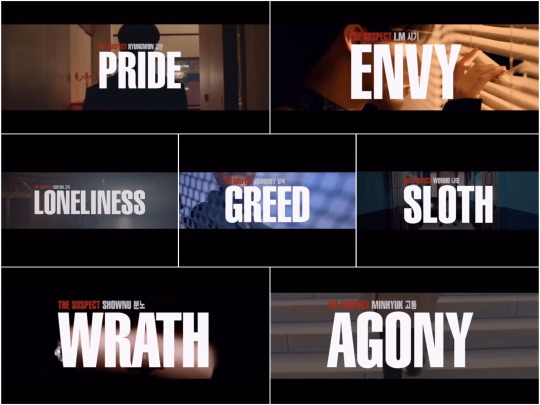
WAR introduces us to seven fine young men who have each committed a sin (two of which aren’t even actual sins, but I understand why they would change those two). Hyungwon and Pride, I.M and Envy, Kihyun and Loneliness, Jooheon and Greed, Wonho and Sloth, Shownu and Wrath, and Minhyuk and Agony. These sins are not actual crimes from a futuristic dystopia (although that would be a cool concept), these are just the personal struggles they are dealing with, the personal backgrounds that consume them.
Hyungwon is a rich kid that believes himself better than everyone. I.M is the local witch (?) who hates the rich kid. Kihyun is probably the only child that was forced by his parents to be perfect. Jooheon and Shownu are a very misguided pair of trouble-makers who’re friends with Wonho, who practices Taekwondo but can’t reach the standard he wants. Minhyuk lost someone important to him.
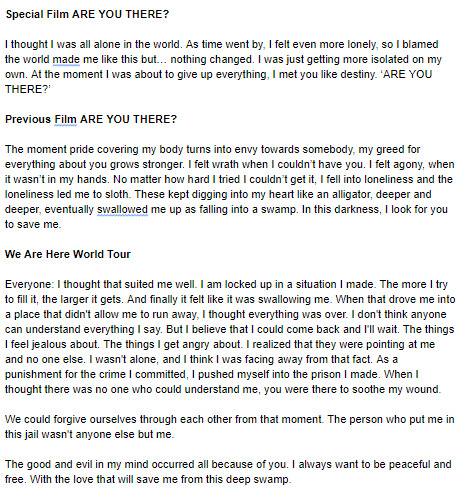
In the Special Film and the Previous Film called ‘ARE YOU THERE?’ they explain these personal struggles, how their situations make them fall into those sins, and how they’re looking for someone to save them. This salvation comes in the form of each other. In WAR they further explain their own sins and how being with each other saved them from drowning in them. Alligator represents the sins and them drowning in the swamp of their own despair. Shoot Out is them breaking away from their past and destroying these sins.
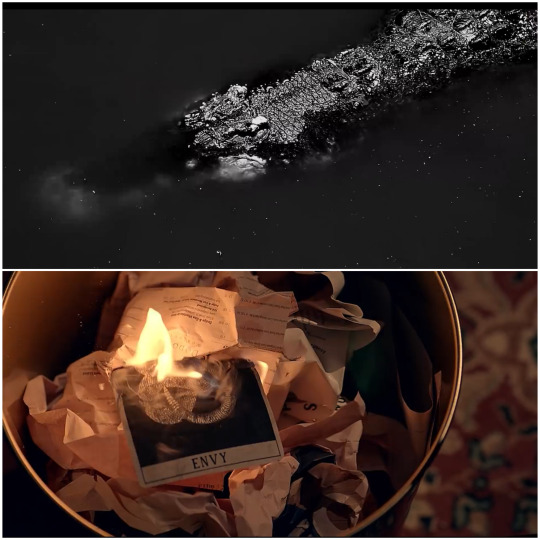
Phase 2: The First Timeline - The Trigger (Find You MV)

Originally I proposed that Hyungwon got his powers by entering that weird heart at the end of All In and Fighter. I’ve now been proved wrong. After they each overcome their past and become friends, Hyungwon’s family has an accident in which both of his parents die and he comes out badly wounded. After he recovers, he’s now living by himself and taking different medications to deal with the aftermath of the accident. The boys decide they cannot leave their friend like that and temporarily stay at his house.
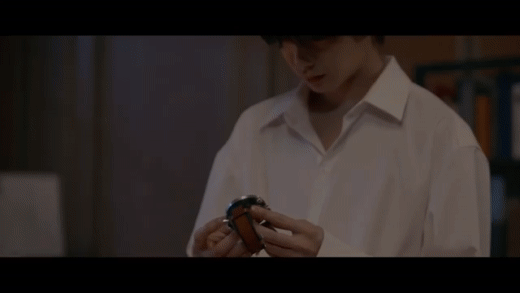
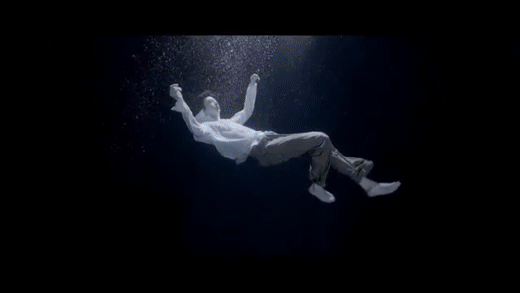
While they’re sleeping, Hyungwon wakes up and visits his father’s study. He finds the damaged watch which sends him to an entirely different timeline. This is showcased by him suspended in the water, with images of Dramarama and Destroyer flashing by. There is a scientific theory that proposes that spacetime is actually a superfluid; I won’t go deep on this because I don’t fully understand it, but showing Hyungwon trapped in water is a good analogy to him being trapped in a different spacetime. This is also briefly shown in The Connect World Tour VCR, (from now on addressed as CWT), but we’ll talk about this one in more detail later.

Wonho wakes up first and notices Hyungwon isn’t there, so he wakes up the others and they try to retrace his steps. Unfortunately, Hyungwon is not part of that timeline anymore, he’s gone for good. This leads us into our second timeline.
Phase 3: The Second Timeline (The Code & The Connect World Tour VCR)
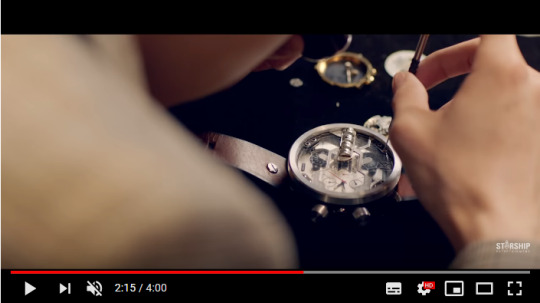
After Hyungwon jumps into spacetime, he becomes lost. Personally, I think there is a possibility that there were other timelines he visited first until he eventually learned to craft the watches himself, as we see in CWT (watch it here). Maybe he just watched this timeline fail a lot of times before he learned and decided to intervene. Either way, Hyungwon actively tries to reunite all of them by giving them the watches. He succeeds for a moment, but in this timeline there exists an agency that controls Time Travel, who frustrate his plans every single time.

It is important to know that in this timeline, the boys don’t all know each other and some of them don’t even exist in the same era. They don’t remember Hyungwon either. Personally I think not remembering Hyungwon might be because he removed his existence entirely by disappearing from his original timeline. There cannot be two of him, as that would cause problems, so instead he just completely seizes existing in all possible universes as he moves through them.

The rest of the boys still exist within the normal spacetime frame though, but they’re lost and ignorant to their true origin. They have forgotten each other and can’t remember yet. However, no matter how hard they try, this timeline is completely doomed because the agency is actively trying to frustrate Hyungwon’s efforts, even if they don’t have something against him specifically. So Hyungwon jumps into the water again, he must continue searching.
Phase 4: The Third Timeline (The Connect: Music Film D & The Connect World Tour VCR)
Destroyer is yet another timeline distinct to Dramarama. We know this because we see different pairings, completely different settings and completely different timelines. The Music Film D is divided in three stages: Part 1 The Code (a very obvious reference, this is already letting us know they’re connected), Part 2 Finding the road, and Part 3 Connected (clear reference to the current album).
D shows us the boys as geniuses, Minhyuk and Shownu are artists, Kihyun and Wonho are science (physics?) prodigies, and Jooheon and IM dominate technology. CWT gives us a bit more insight and shows us something very important: they have begun to remember each other and they have memories from their previous timeline. They want to find the person they were paired with in their first timeline, but more than that, they also have memories of Hyungwon’s intervention, even if they don’t remember him properly (because let’s remember Hyungwon removed himself entirely).
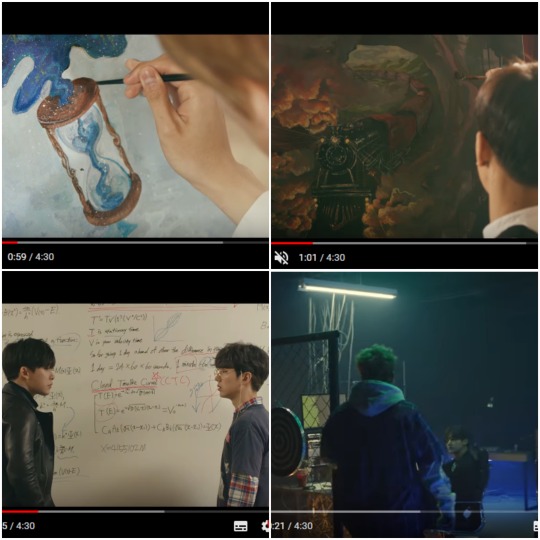
They know they have to find someone, and so they set out to do it. Through their own methods they all come to the revelation on how to find Hyungwon. Kihyun and Wonho do the math, Jooheon and Changkyun use technology, and I guess Minhyuk and Shownu have a vision which they paint? Not sure on that one to be honest, but they find the train station.
This could either be a real place in which every timeline and universe converge or just a metaphor for them figuring out how to do the same thing Hyungwon does, either explanation works.
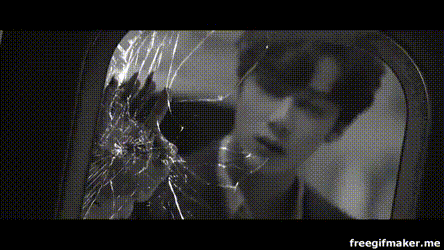
Hyungwon is trapped in this train, which is another analogy, but this time for the (liminal) space between dimensions. He’s tired himself out trying to reunite the others, and this time they must come for him, and they do. They find each other, they remember, and they reunite once again. This time nothing can pull them apart.
Phase 5: Interlude (The Connect: Jealousy & The Connect World Tour VCR)
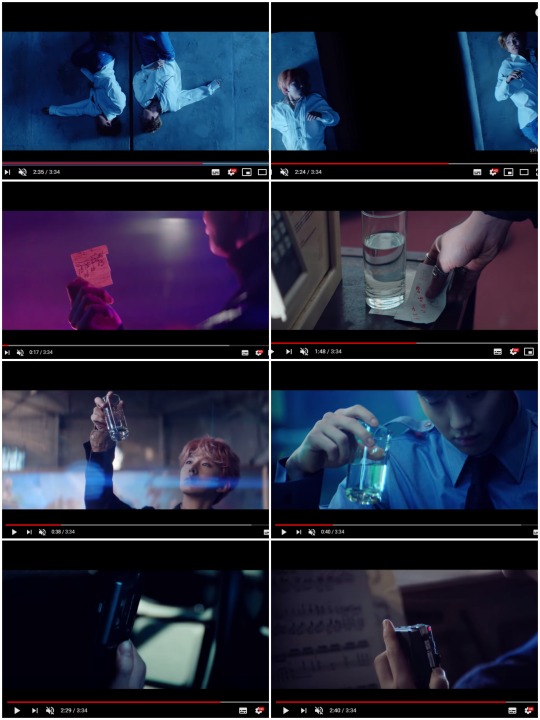
Jealousy doesn’t feed the plot itself but helps connect (pun not intended) and put everything else into place. Through different imagery, Jealousy illustrates how the different timelines push them together and then pull them apart, creating different pairings, but that despite this they still share things in common (the paper with numbers, the recorder, the glass of water). Another thing this video does is allude to Jooheon’s death in Dramarama through the use of os symbolism. In one scene, a paper with his symbol is being burned, while in yet another, the chair he’s seen sitting on throughout the video is being burned as well and then falls down to the abyss.
On the other hand, CWT creates a clear and obvious connection between Dramarama and D, revealing to us that they do have memories from other timelines. Another cool thing is that we get to see Hyungwon on the rooftop where they filmed Hero, released back in 2015. It also provides a clearer scene of Hyungwon crafting the watches himself and of him at the top of the Hero building. We can also see the last scene from Jealousy mirrored in the last few seconds of the VCR, which is something worth pointing out.
But, as the VCR says “when everything goes back to the beginning, someday, we will be connected again”. Where did things begin? That’s right, in Find You, so the next step is Follow.
Phase 6: The Third Timeline - Back to the Beginning (Follow)
If Monbebe has a war anthem, it is most definitely Follow, which is an amazing song. Unfortunately, Starship has decided to stop providing explicit story development on their MVs since Jealousy, so Follow doesn’t do much for the story itself. However, I have three important reasons to believe this is where the circle ends: all of the references to time, the quote from CWT,and the very last scene of the MV. Let’s go in order.

The most obvious reference is them standing on clocks painted on the floor, but that’s not the only one. We get to appreciate a few watches here and there, reminiscent of Hyungwon’s in D and Dramarama, and also see the movement of their shadows as a passage of time. The most important reference though, is the cover of the album. The title, “Follow” is solid and then becomes “liquid” as it moves down. This makes sense when you consider the other two points.
First of all, “when everything goes back to the beginning, someday, we will be connected again”. The beginning of the whole mess is Find You, part of the Follow album, there is no doubt about it, so why is Follow the end? Well, because of the last scene in the MV. I know it’s Shownu standing at the top of the stairs in front of the circle, and while it would be better if it was Hyungwon for the sake of this theory, we’ll just completely ignore that. That circle they’re walking towards is the train. ‘Follow’ in the cover becomes fluid because once they cross that circle or enter that train, they too remove themselves from existence like Hyungwon.
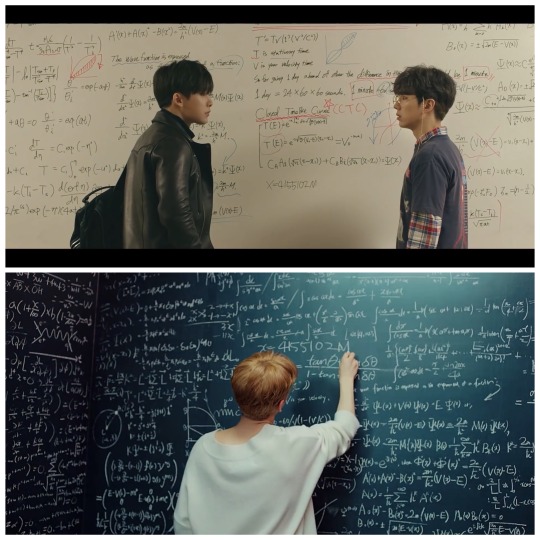
That’s not the only thing though. In D, Wonho solves the formula for time travel as X=4155102M, he does it again in Alligator and I believe it’s also briefly shown in WAR. Kihyun also travels back to 2015 in Dramarama to save Jooheon, and Hyungwon is standing on Hero’s rooftop, which was released back in 2015. Their debut date is their beginning, and they keep referencing it over and over because they’re trying to go back to the beginning in order to solve everything.
They went from Find You to Dramarama, to Destroyer and now they’re back at the beginning with Follow; they are connected again. They have different faces and personalities because they’re not the same people from the original timeline, but they managed to find each other and transcend spacetime to be together. So now, what happens next?
Phase 7: Moving Forward (FANTASIA X)
Here is where things get a little complicated, both in the story and in real life. With Wonho’s departure from the group (go support his solo debut), we now have an even number, which wouldn’t seem like a big deal if it wasn’t for the FANTASIA X Trailers. In each trailer we see that each one of the members now possesses a device which allows them to control time in one way or another.
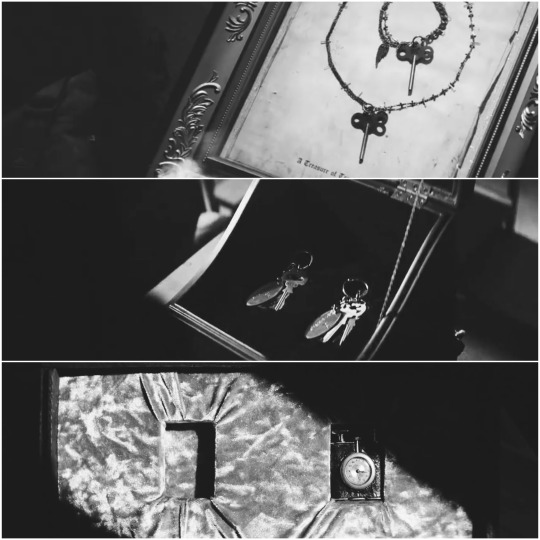
Hyungwon and Shownu have keys, which when used to open anything will allow them to do spacetime travel (I would say only time but, well, I have no way to confirm this right now). Jooheon and I.M have this lighter-watches that when turned on, they allow them to stop time. Kihyun and Minhyuk have another very different set of keys that look like those in old toys or music boxes, which allow them to ‘rewind’ time when used.
Now, them getting powers is expected, since they also removed themselves from the “normal” existence and joined Hyungwon. I assume it is because of the even number that they gave Shownu the same powers as Hyungwon, but it makes it a little weird because Hyungwon has been special all this time. It also doesn’t make much sense that now Hyungwon is using a very different instrument. I want to believe that Wonho is supposed to be in Hyungwon’s place in the teaser, but it’s impossible to tell now.
Even ignoring all of that though, FANTASIA X overall just doesn’t make much sense with the theory. Sure, it’s still time related, which is like the biggest giveaway, but the boys still look lost and like they’re looking for something despite the fact that they already found each other. Maybe the Teasers could be their personal research into spacetime travel and their attempts to find Hyungwon, but I highly doubt so. I think it’ll make more sense after the next comeback or tour, since so far everything seems to come in threes (Dramarama, Destroyer and CWT, Shoot Out and Alligator and WAR, Follow:Find You, FANTASIA X and?).
Conclusions
Despite the fact that we can no longer call it a Universe Theory because it hasn’t been there since the start, I still think it is a story about them, about their struggles and how they’ve grown up. They’re each other’s friends and family, the value of X is their debut date because that is when they came into existence, they are each other’s dreams because they wanted to become artists and they did so by coming together into one group.
A lot of things have happened, but their friendship hasn’t changed. They got each other out of the swamp and helped each other overcome their difficulties in the hardest times. It is uncertain as to where the story will lead us next, in a way, I think this might be the start of a brand new story for MONSTA X. A direct consequence of the story they have carried out since The Code? Maybe, but probably very different and not exactly in the same storyline. It’s hard to know, but I’m excited about what they have in store for us nonetheless.
I hope you liked this theory, and be assured that I’ll add onto it as more things come out and new mysteries are to be solved. If you have any questions you can hit me up on my asks, Twitter (@soft_bluenicorn) or my CuriousCat (@soft_bluenicorn)! I’ll be glad to answer them ^^
#monsta x#monsta x theory#monsta x shownu#monsta x wonho#monsta x kihyun#monsta x hyungwon#monsta x minhyuk#monsta x jooheon#monsta x changkyun#shownu#wonho#kihyun#hyungwon#minhyuk#jooheon#changkyun#bluenicorn does theories
36 notes
·
View notes
Text
Chihayafuru | Why read it?
This is a comprehensive, non-spoilers review I made of the series on Goodreads recently, and I thought I would leave it here for potential readers as well. As the series will come to a close within the next year or two, there’s no better time to pick up Chihayafuru than now. The following review covers: a basic summary of the series, a brief explanation of karuta, highlighted aspects of the narrative, and common misconceptions. Enjoy!
Chihayafuru primarily follows three childhood friends—Chihaya, Arata, and Taichi—and their journey through karuta, a Japanese sport inspired by one hundred classical poems found in the famed Hyakunin Isshu. The trio bonds over karuta as children before they're inevitably separated due to a number of circumstances, until their paths cross once again in high school. Their efforts to rise to the top of the sport's hierarchy in Japan parallel to their personal relationships with each other, as well as their insecurities, hopes, and fears for the future as they grow up. REP: visually disabled SC. TW’s: verbal parental abuse.
Karuta (or more specifically, kyogi karuta) is a Japanese card game. The poems of the Hyakunin Isshu are transcribed onto two sets of one hundred cards each—the yomifuda, or reading cards, have a full poem transcribed onto them, while the torifuda, or grabbing cards, have only the second half of a poem transcribed onto them. Each player has a territory with twenty five cards, and the object of the game is to grab the correct torifuda as soon as the corresponding yomifuda is read. There are also a few more complex rules, but ultimately, whoever clears all of the cards in their territory first wins. Karuta is a game that tests memorization, agility, hearing ability, strategy, stamina, etc.
The following are aspects of the series that I think really make it stand out!
The expansive cast. Karuta is an all-ages competitive sport. People from all walks of life compete against each other, so there's a broad range of characters introduced across the course of the series: old doctors, married women, high school teachers, elementary students. It makes the personal experiences and learning points of the various characters all the richer. The appearances of background characters are also consistently recurring, which makes the fact that the cast is so expansive even more enjoyable, because no one is truly forgotten or cast aside.
The emphasis on teachers. An experience Chihayafuru especially explores in depth is that of teachers, both literal and figurative. They are constantly brought into focus: as competitors capable of displaying as much persistence as their juniors, as mentors who do their best to nurture the younger generation, and as people of a past era fighting to hold onto what grasp of the present that they have left. Their insight is invaluable to the younger characters that the series primarily focuses on, and they can hardly be called backseat players.
The exploration into parent-child dynamics. Although the angle from which Chihayafuru explores parents and their influence on their children is a little different, it's also a just as valuable portrayed experience that I adore. There are parents who give their everything for their children, parents who don’t understand their children’s ambitions but support them as best they can, parents who demean those ambitions and create everlasting insecurities, parents who use their children’s ambitions for their own gain, etc. I think in that sense, there’s at least one parent-child dynamic that every reader could potentially relate to and find catharsis in reading about as these relationships grow and change.
The series' refusal to treat karuta as insular. A lot of sports manga have a tendency to focus almost exclusively on the sport in question, with no thought given to the characters' real-life problems, their families, or their future after high school. Chihayafuru, rather than making karuta the object of its story, instead makes it the narrative medium by which the characters' life stories are told. It's a series about people and their problems more than it is a series about the sport, which is what best sets it apart. The characters are constantly faced with the reality that they will have to confront their future and the need for a career at some point, because karuta isn’t a sport that pays nor one necessarily super-famous in Japan.
The use of poetry to parallel the events of the narrative. On the surface, karuta is just another card game; but what makes Chihayafuru special is that the poems being read at different parts of the story actually further contextualize what is happening. Although the course of the story can be understood without looking up what each mentioned poem means, there’s no denying that looking up the meanings adds so much more to the experience. It's one of the best Easter eggs the series has to offer, and it also lends further understanding to why players must cherish the cards for what they mean in order to truly love the sport. (Also, if you are into classical poetry and/or the use of nature-associated metaphors to illustrate life, this will definitely appeal to you!)
The analysis of the human psyche. There are several types of relationships and personal problems Chihayafuru explores. In particular, the friendship between Chihaya, Arata, and Taichi is complex. Their love triangle is deeply entrenched within each of their individual relationships with karuta and their individual insecurities, which is what makes it stand out to me as one of the best of its kind. Each of these characters undergoes expansive development as an individual, and yet the three of them are also inextricable of each other in terms of that development and their goals. There’s extensive exploration into what it means to truly love a sport, whether natural talent or hard work is more valuable, how ambition and success achieved at the cost of loneliness is to our own detriment, and whether the expectations of an older generation will define all that we are capable of becoming.
The exploration of playing as an individual versus as a team member. Karuta is a sport that can be played in teams (up through the end of grade school) or individually. Both aspects of play offer different insight into the nature of sports in general, about the characters' personal goals or desires, and about their complex relationships with the support systems that surround them, or lack thereof. There’s a huge emphasis put on the fact that ultimately, while experiences garnered while playing alone are valuable, karuta cannot exist on the backs of isolated individuals alone. Human camaraderie is necessary in order for the sport to thrive. One of my favorite quotes from the series is regarding this complex theme: Team matches are solo matches. Solo matches are team matches.
The women! Among its equally (or more) famous peers, Chihayafuru is perhaps the series that emphasizes on uplifting of women and women's friendships the most (an advantage lent to it by the all-ages, all-genders nature of the sport). There's a vast cast of female characters, and Chihaya and Shinobu in particular are protagonists whose strength is never undermined by the fact of them being women or the object of someone's affections. The women of the series are strong, air-headed, determined, lazy, ambitious, lost. There’s a vast array of experiences illustrated by them, and they’re allowed to embrace their womanhood while also refusing to be limited by it.
Here are some misconceptions about the series that I have seen encountered by both dedicated and casual readers (or viewers):
It's a series with little emotional payoff. As I mentioned before, Chihayafuru is most prominently a series about people and their problems. The personal journeys the characters undergo span hundreds of chapters. I've noticed before that some people give up on the series as a result, because their favorite character isn't where they want them to be within whatever span of chapters, but I want to encourage potential readers to not give into this inclination! This is a series where you need to be in it for the long haul, because the emphasis is that these emotional problems characters face are not ones that they can solve within the span of a few months. Sometimes, they take years (aside from the first volume covering a flashback sequence, the main narrative takes place over the course of three years).
Perception of the love triangle. A lot of people tend to zero in on the love triangle and make it their focus of reading, and especially for readers who attach themselves to Taichi, this often leads to disappointment in where the narrative leads (as he is a character who struggles immensely on his journey towards growth and self fulfillment). It's important to remember that each member of the childhood trio is their own individual! Issues tied to the love triangle are certainly important, but readers often miss out on crucial emotional development for characters because they're too focused on who they think Chihaya should end up with, when that's not even remotely the point. The narrative almost always emphasizes that at the heart of it all, Chihaya, Arata, and Taichi will always have each other. What matters more than the outcome of the love triangle is whether their friendship will ultimately heal and thrive, and whether they will grow as individuals who can support each other rather than act like crutches for each other.
This is not a series about sports! This may be a confusing thing to say, and it may not even be something that other Chihayafuru fans would agree with me on. But again, I'll reiterate: Chihayafuru is most prominently a series about people and their problems. Some matches can span several chapters, while others barely last a few panels. The focus is not so much on the sport as it is on what the sport or match is doing emotionally for the individual. In that sense, it's a bit different from its contemporaries, where almost every important match is covered in detail, from one move to the next. Although there are plenty of moments where karuta matches are covered in detail, don’t be surprised if there are moments where they proceed too fast, and think to yourself why showing the whole match may not have been necessary!
These are the main points that I could come up with, but if you have any questions, feel free to send me an ask on my blog. I hope any part of this can convince you to read Chihayafuru, as it’s a wonderful story that offers a lot of layers to dissect to its audience. There’s always something new to discover with it, and that’s what makes it special.
#chihayafuru#ayase chihaya#mashima taichi#wataya arata#wakamiya shinobu#meta#i'm just tagging them all so it gets spread gjfkgjfkdhl#but uhhh. i hope this is comprehensive#also if you disagree with anything pls send me an ask!#rather than reblog onto it with an essay or something gjfkjhlgdf#since this is a recommendation post i want to keep it clean#and as accessible to others as possible
41 notes
·
View notes
Text
A look at: AP BIO S3EP6, “That That That”
So this post is going to be sort of an... in-depth analysis for this episode. I hope people enjoy reading this! It’s a long one, so I apologize in advance. I hope it doesn’t feel rambly.
So the episode opens up with the janitor talking with some rats.
We are treated to a shot from their point of view, as the man talks about the rats’ plead about how they’re “going to change”, and how they say they’re not “going anywhere”. Through this simple quick scene, the episode sets up the entire premise, both on a literal level, with the use of rat poison later on, and on a thematical level, introducing us to what’s going to become, by the end of the episode, Jack’s own point of view. Putting it like this, it’s like already the show is drawing a parallel, making us further empathize with Jack as he slowly starts feeling like a rat stuck in a maze himself.
As we’re introduced to Jack, he talks about preparing a recorded lecture for the University of Wisconsin on trascendentalism.
Jack feels sure that what he wants is to get away from the school he’s in, that he won’t miss anything. He thinks this job is what he wants.
Now, trascendentalism is a philosophical movement that values the importance of subjective intuition, not reached through logic but through imagination. It preaches that people deep down already know what’s right for them, that the individual’s potential is limitless, and that the ego is not your true self. All themes that are slowly woven into the episode as Jack works through his subconscious while high off rat poison to come to the conclusion that he already knew deep down was right, and that he started feeling right at the start when people started questioning him.
As this process begins, he goes to talk to Lynette, his girlfriend. He brings up said lecture that he’s recording, it almost feels like he’s seeking her reassurance.
After that, we see him in the teacher lounge, kind of minding his business.
The scene starts out with the three teachers talking. In the frame, catching my eye immediately, is that fourth empty chair. It underlines that someone’s missing, someone that could be a part of what’s happening.

Eventually we cut back to Jack being in frame, except not really, because he starts out of focus, in the backgroung, listening in to the three teachers, framed like an outsider. This is to show us how he feels in the environment.

Then, as he enters the conversation, he gets into focus.
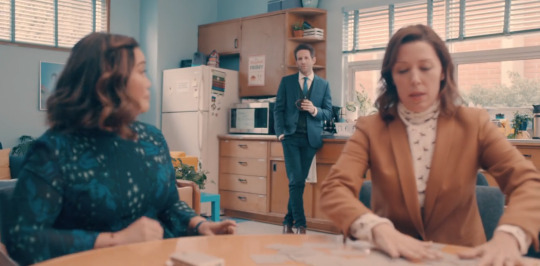
And we then cut back to the three of them.

There is a purposeful distance felt between the two parties, and it’s one that Jack is establishing by keeping himself to the side. This calls back to the themes of the episode right before this, Mr. Pistachio. They’re inviting him in, there is a place for him, but he feels like he doesn’t belong, he stays distant.
As the girls start talking to each other again, Jack is once again kept out of focus, but still clearly in the middle of the shot, which tells us we should still be paying attention to him.

And pay attention to the visual hierarchy, as well. With Jack pushed to the background, he appears small in comparison to the other figures who are big and overpowering. The full body shot, as he resists getting closer to them, almost feels revealing. Emotionally, what this communicates to us, to me personally, is a deep sense of vulnerability that Jack is feeling.
As he subconsciously starts to doubt where he truly wants to be, he feels exposed and out of place.
After this scene, Jack goes to talk to Durbin, and this is where we’re introduced to yet another small subplot that serves to reinforce the themes of the main one at hand.
Durbin is presented with an issue. He wants to tell his brother that he loves him, he has struggled with it in the past, and this is the week he is gaining the courage to do it. This plot will ultimately end up reflecting Jack’s own epiphany, but we’ll get there.
So finally, it’s late evening, school’s empty, and Jack has prepared the set up to record the lecture.
Visually we’re introduced to this duality of Jack on the screen of the ipad versus the real Jack trying to give a lecture. The perfect competent appearance that actually masks his doubts and hesitation.

Screens being often used in media to show something perfect, fake and unachievable, and this is no exception.
Jack starts its lecture:
“To achieve its perfect form, a caterpillar must withdraw and complete itself alone, in its cocoon. Likewise, for us to achieve spiritual perfection, in the view of trascendentalists like Henry David Thoreau, it is necessary to retreat from the mindless and negative influences of society.”
This ends up being exactly what Jack does, as the rat poison induced trip lasts him an entire week, stuck alone in school, with nothing but his delusional and hallucinatory thoughts, he is forced to confront himself in complete solitude to come to the conclusion that was inside him.
He then commits a mistake, right at the end, calling Henry David Thoreau “Justin Thoreau”, the same way Mary, the teacher, did before. In a way, the school and the people in it are rubbing off on him, their presence in his mind manifests through this lapsus, effectively keeping him from completing the lecture correctly. Keeping him here.
He starts stumbling. He starts doubting himself.
“Is that right?”
He asks, the question resonating bigger than just about his current speech, feeling more like about his path in life and his actions.
A shot quickly zooms in on the camera lens, the frantic pace communicating anxiousness, but this shot in particular serves to fully immerse us in Jack’s shoes.
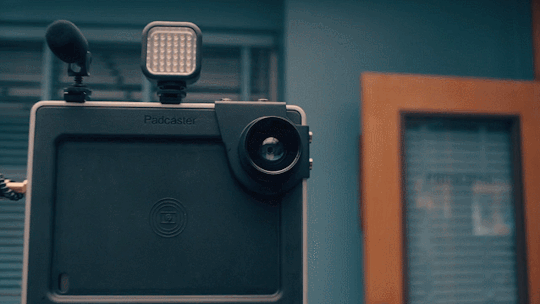
Feeling watched, feeling judged, scrutinized. Having to directly face his shortcomings, unable to blame anyone but himself, and having to ask himself why. The camera almost literally backing us - therefore, Jack - into a corner by coming this uncomfortably close to us.
He attempts to hype himself up and tries again. The whole thing accompanied by a background music that’s basically nothing if not ticking (like a clock) and percussion. It feels quiet and tense.
We then get another shot that’s a clean transition from the screen to the real Jack. In the screen, he appears confident, but as soon as the camera focuses on the real Jack, he loses tracks of what he was saying and once again struggles. Quietly, he turns to look at the background.
He slowly, tentatively reorganizes a single book, then positions himself back, only to turn again towards the bookshelf, still dissatisfied.
Without a single line of dialogue, this shows us precisely what he’s feeling and lets us understand his slow descent into madness. He feels that there’s something wrong, out of place, something that must not be right, but he’s not yet looking at himself to fix this problem, instead he’s looking at his surroundings, trying to gather back the control that he feels he’s rapidly losing by attempting to control what’s around him.
And so he deeply cleans the entire office, reorganizes and color codes the books behind him.
Being introduced to his struggle before the rat poison even starts to affect him lets the transition between reality and hallucination feel seamless, so much so that during a first viewing we start to doubt what’s real and what’s fake, and when.
The overall eerie tone of the episode makes it feel like a take on psychological horror, as the slow loss of control is accentuated by increasingly bizarre events that go completely unquestioned.
Attempt after attempt, we feel as though we are entering a loop with no chance of escaping. Which is exactly what Jack feels.
We then get this.

Jack is fixating on his issue, without much success in resolving it. He’s facing and confronting it over and over. Visually, it’s made bigger than himself by its oppressive presence in the frame.
The only soundtrack accompanying this is a kind of vibration, a deep and hard to hear sound that just looms in the background. This episode in general is very quiet, which helps the atmosphere feel lonely and tense.
He screams, but there’s no one who can hear him. It’s just himself.
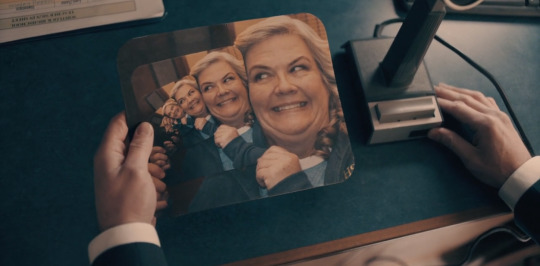
He sees this mouse pad and once again the picture visually reinforces this sense of looping, of feeling stuck and trapped in a repeating endless cycle.
He tries to rip it in half. But he can’t.
Just as he can’t overcome what he’s struggling with, his own cycle that he’s stuck in. He wants to break free, but he’s not sure from what. Is his prison this school he says he hates so much, or is his prison his own ego, trapping him into feeling like an outcast, into isolation, into never opening up or being vulnerable.
This is actually a theme in the entire season, Jack slowly learning to open up and be vulnerable. But this episode in particular feels like a turning point for his character, a moment of realization, of personal intuition. Trascendence. Beyond his limits, beyond his own walls. Through a trascendent experience, the hallucinations.
He falls asleep on the floor, visually representing his rock bottom.
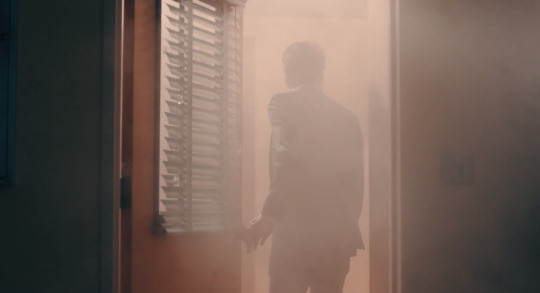
He’s then woken up, there’s faint wind chimes sounds, and he’s surrounded by darkness in a way that feels ethereal. As he exits the room to check the source of the smell that’s almost calling to him, we see nothing but him entering light.
He’s barely visible, surrounded by fog, he can’t see where he’s going very well.
He sees a figure, and asks this:
“Are you in a caterpillar costume?”
When the figure turns to face him, Jack is frightened and runs away.
This immediate association between the very subject he was talking about, and him fleeing in terror, serves to illustrate his true feelings towards what he’s doing by recording this lecture. He’s scared of it, and he’s running away from it.
He wakes up again in the same room as he was before, only this time the light is almost blinding.
Here, Helen appears. This dialogue follows:
Jack: “Jesus, Helen, what are you doing here?” Helen: “Oh, you know I can’t stay away from Whitlock long.”
We quickly find out that this is a dream sequence that Jack is having. Thanks to this knowledge, we know that all the dialogue Jack entertains with the rest of the school workers, all his friends, is nothing more than his internal dialogue manifesting to him through them.
He’s asking himself why he’s at this highschool. The other voice, Helen, replies that it’s because they can’t stay away. They like being here.
But this realization comes with horror and shock to Jack, and so it quickly turns into a graphic, horrid description.
He once again escapes it, going immediately to try recording his lecture again, but Helen bursts into the room kicking the door. All these terrifying thoughts are tormenting him.
He runs away, camera in his hands. Gets interrupted once again.

In this attempt, we are completely unable to see him through the screen because of how out of focus he is to us in there. His attempt at a perfect facade is proving completely infructuous, all we can see is the real Jack, deeply struggling.
He gets interrupted by the three teachers again, and this dialogue happens.
Michelle: “Jack, you’re here! We thought that that video would be done by now.” Jack: “Uh, yeah, unfortunately... it’s not.”
Once again doubt seeps in as he worries about what’s taking him so long, it’s also interesting to notice how the girls use “that that” with no problem whatsoever.
They invite him to join them in playing a game, and he finds himself going along with them at first, before stopping himself, panicked.
Jack: “I don’t have time for your dumb, fun games! I gotta do this video!”
This dialogue sets an intense contrast with the scene with them at the start, in reality.
In that scene, he calls their games “terrible”, then looks at them with fondness.

Here, instead, he’s stressing that he doesn’t have time for it. He wants to participate, as is shown, but he can’t because of his own self imposed obligation.
In other words, this is exposing to him, though still through an horror lense, his realization that he’s gonna miss all these chances to hang out with his friends if he goes through with it.
He keeps running away, and ends up in his class.

His reflection in the screen appears now deeply warped.
The writing on the whiteboard is upside down, something is deeply wrong.
He’s alone, then all of a sudden he’s not, as the camera twists to the side and gets closer.
We are treated to some dutch angles.
He tries again, but the words aren’t even his. He asks if he sounds like Marcus, and the students all nod while creaking sounds can be heard as they do.
Day 2. He’s still eating the same spaghetti as before, and he accidentally gets sauce on his shirt. A stain that just won’t go away. A visible imperfection. He snaps, he covers himself in them, then puts on some makeup powder, helplessly trying to cover it all up. Of course, that does nothing. He’s trying to bury a problem that has become impossible to conceal.
Getting in front of the camera again, he says this:
Jack: “I want this job. I’m so overqualified.”
It’s like he’s trying to convince himself, since he’s not really talking to anyone but a camera lens. Then there’s the part about being overqualified. The thing is, he’s right, and he know he’s right. On a qualification and competence standpoint, he should be able to ace this, no problem. So why is he struggling? Does he want this job?
In comes Durbin.
Durbin: “Jack! ...you’re still here. Working on your video.” Jack: “Yeah uh- but everybody keeps stopping me...” Durbin: “Let’s get you back on the right track. What’s the problem?” Jack: “I got sketty on my shirt...” Durbin: “I’ve got what you need right here. Everything you need is always right in front of you, Jack. Always check the lost and found.”
Lots to unpack here. Everytime Jack encounters someone again, they always comment on how he’s still at school, he hasn’t left. He keeps getting stopped, his subconscious keeps stopping him, since we know this is all a hallucination. He’s going down the wrong path, and Durbin in this situation represents what’s right for Jack, the truth in his subconscious. “Everything you need is in front of you”.
Additionally, the way he explains the problem, speaking like a sad child, makes you feel just how lost he is, just how small he feels. Him feeling small, lost, vulnerable and scared is a huge theme in the entire episode, as you can see.
So he tries again, and this is where we first experience the transition. As Jack is enthusiastic to put on the suit Durbin gives him, we then see that his appearance in the screen is quite different. He looks ridiculous. But in his reality, as his real self, he looks spotless, happy. This is him starting to accept the concept that what he needed was always in front of him. Because whereas the screen just shows us what he wants to present himself as, his facade, the real him shows us his true feelings, how he feels towards this highschool and all his friends and the life he lives here.
By accepting his life as it is, his job at Whitlock, he knows he might end up looking ridiculous and his image may suffer, but inside he feels better, he feels good, happy, realized.
The expression he makes as he sees this suit, is the expression of a man that has found what he was looking for. This is why it emerging from a “lost ad found” box is very significant symbolically.
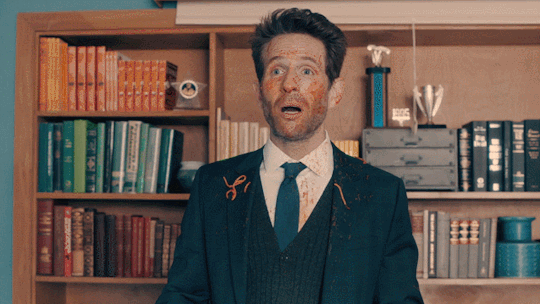
It’s not just himself that changes inbetween “reality” and “screen”, however, it’s the entire location. His background, everything.

He finally finishes his speech, successfully this time. But Helen comes to take the camera and tripod away.
Jack accuses her of “sabotaging him”, but we as the audience will soon come to realize that he’s sabotaging himself.
He runs after her, and as he does, the lights around him start malfunctioning once again.
He opens a door and sees his mother with a young Durbin. He’s understandably unsettled. His mom having always been something close to his heart, we can even see her as a representation of his most intense emotions and of love. He’s struggling to fully come to terms with admitting that he loves being at this school.
He gets away, only to come closer once again once he hears more noises. He opens the door.
He gets in, softly asks for his ipad, and as he walks closer we get an overview of what’s happening. Jack, on his desk, being dissected by his students, completely torn open.
Once again, this visual serves to show Jack’s sense of uncomfortableness with being open and totally vulnerable.
He’s being scrutinized and studied and analyzed all the way to his deepest insides. It’s scary, it’s uncomfortable and it hurts. “I think I found the heart.” “Girl, that’s his bladder.”, he’s being judged mercilessly. That’s how he feels.
“How would we know? We never learned biology.
There’s a sense of guilt for never doing what he should’ve from the very beginning. He regrets not being there for his students, teaching, he���s scared that he’ll never get the chance now that he knows he wants to. This is manifesting though Sarika.
Jack: “I have to go... why are you keeping me from leaving?” Marcus: “We’re not keeping you from anything, Mr Griffin. You’re doing all of this. Your mind has created an entire world of distractions to keep you from doing that video.” Dan: “You know, it’s almost like you don’t want to leave.” Jack: “Yes I do? ...I think I do...”
In this moment, his most open one, he’s finally confronted with his desire to stay.
And this is when he wakes up.
Now back in reality, his appearance in fact resembles the way he looked like in the screen in his mind. So to reiterate, the real him in his mind was simply how he felt, while the screen was the way people see Jack in real life. At this point in the episode, subconsciously, he has come to fully accept it.

He does try to fix up the room, but it’s too much of a mess by now.
We cut to all of his friends discussing together. In comes Helen, with her nose bandage, and she says this.
Helen: “Oh, I’m so glad to see you guys!” Mary: “Helen, what happened?” Helen: “Well, I’m starting to think that the relationship I have with that animal is not what I thought it was.”
This dialogue is meant to reflect Jack’s situation, as do all the subplots in the episode.
The dialogue continues when Helen asks Durbin how it went with his brother.
Helen: “Did you tell your brother that you loved him?” Durbin: “Oh, well, I... kinda sorta chocked on saying that exact phrase, so...” Michelle: “That’s okay Ralph, it’s hard to be vulnerable.” Stef: “Yeah, and you have to respect the fact that he may not be there yet.” Durbin: “Yeah, I just feel kinda bad because a bunch of times he said “I love you” and I said “Yeah, good good good good good”...” Helen: “Well I’m sure he knows how you feel.” Durbin: “Well, at one point he said “Do you love me? Because I can’t tell.” and I said “I don’t know” and I got into a lift and went to the airport, just full choke.”
This all reflects Jack’s own feelings. He’s not quite at a point where he can openly admit to loving his friends and Whitlock, but at the same time this dialogue shows us that they are understanding of it, they know that being vulnerable and open can be very hard, and they’re patient. They do know that Jack loves them.
Enter Dave, in a wheelchair, injured from head to toe.
Dave: “You know who else choked? Maybe the hardest of all?” Everyone: “JACK!!!”
Enters Jack. Everyone cheers his arrival.
Of course, the dialogue just quoted is a joking way to point out how Jack failed in making that recorded lecture.
He shares a cute moment with his girlfriend, and softly says:
Jack: “You were thinking about me...”
It’s like it comes as a surprise to him, that he’s loved, that other people genuinely like him and want him to stay.
He continues.
Jack: “Um, hey, I should talk to you about something. Uh, in fact, I actually have to tell all of you about something important that I realized while you were gone. I realized that-”
He’s interrupted but the janitor which he had previously punched. The guy who was doing the rat disinfestation.
In other words, he chokes, as well.
Mary: “So Jack, what did you learn?” Jack: “Uh... well, I, uh... I invented a new game.”
Instead he chooses to bring that game he hallucinated into reality, making time for it. Being enthusiastic for it.
He enters his classroom.
Jack: “Alright, everybody, shut your precious beautiful mouths. You know after spending an entire week alone in this empty school... I realized that I can’t survive without community. And I came to appreciate... all of you.”
This reflects the trascendalistic philosophical approach of Thoreau, who retreated alone in nature to find true purpose in life.
He goes to write on the whiteboard.

All his previous writing wiped but still visible. He did do all of that, but it’s gone now, it’s no longer present. It’s solved.
Jack: “And I decided that I wanted each of you to finish this year knowing more biology than any student ever has...” Sarika: “Mr Griffin? I know we’ve had our differences in the past...” Jack: “Uh, yeah, hold that thought, Sarika, because the biggest thing that I learned is that prolonged exposure to rodent killing gas causes hallucinations and irrational ideation. And all these things that I thought I learned? Well... chemically induced illusions... caused by a dying brain”
He draws an X on top of the words “community”, “you” and “biology”.
Jack: But! Now... I got my thinker back in the pink. Everything’s back to normal...”
He takes out a bunch of spaghetti and a box of rat poison, sprinkles them heavily with it, and takes a bite like it’s the most normal thing.
So what does it mean, is he rejecting all that he learned? No. He’s keeping up his facade, as being vulnerable is hard, but inside he’s embracing what he learned. This is communicated to us through him ingesting the poisoned spaghetti, going back into his mind, accepting the embarassment and weirdness and going back to that scary feeling of vulnerability for more. He might say that it’s all back to normal, but we clearly see it’s not, and we clearly know that he’s glad to be back and stay back, we see it through his actions.
Ultimately this is a sort of turning point for Jack Griffin, while he might not yet be able to express his feelings, while still going back to a place of denial using the rat poison as the excuse for everything that happened in his brain, this is his first step towards accepting what his subconscious has known all along, his first step to “trascend from a caterpillar into a butterfly”.
This is... trascendentalism, as construed by AP Bio.
#ap bio#glenn howerton#jack griffin#analysis#that that that#ap bio season 3#ap bio season 3 episode 6#yall i cannot believe i just wrote 16 pages of analysis in a single sitting from 3am to 8am#i am literally insane i think#but i hope whoever reads this takes something out of it#glenn howerton if you are reading this i love you buddy youre very talented but please make macdennis canon or i will have to unstan#just kidding im not going anywhere but please bud#does this count as a review#or is this just the ramblings of a crazy person.............#I think I'm right personally#at least somewhat#jack griffin bisexual legend#ok im done i think#when u follow a sunny account for sunny content and then BOOM 16 pages of ap bio analysis#that relatable moment when..........#dont yell at me i know im a mad person but i HAD TO OK
19 notes
·
View notes
Text
November ‘20
Cross Code
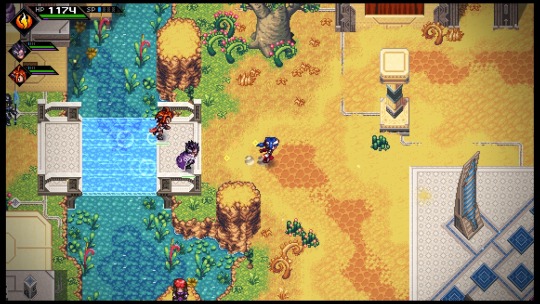
Cross Code is a game that is trying so very, very hard. The story is based around your character being an avatar within an MMORPG, and its this kind of game-within-a-game setup that is used as a cheeky way to skirt the fourth wall and have its characters make snide remarks at certain design decisions, while also going full steam ahead with them regardless of the fact. Don’t think we didn’t notice, dev team! It plays out as a 2D top-down action RPG, but clearly has aspirations that extend far beyond this framework. Each of its environments is thoroughly layered with subtle verticality, with parkour-esque platforming having you constantly working backwards from your intended destination, and requiring meticulous attention to detail in order to find where it is you’re able to begin your elaborate series of jumps from. There’s a huge array of materials to gather and channel through traders and to craft into gear, and the combat they benefit is both precise and complex, requiring plenty of on-the-fly thinking as well as tight execution. As well as these set-piece battles, the game’s dungeons are full of puzzles that though smart in construction, are tough enough in isolation, and frankly brutal in their relentless frequency. One particularly ill-advised chapter has a series of three such dungeons in quick succession, and perfectly illustrates that just because you can, does not mean that you should.
On a more positive note, one thing the game does have in spades is charm. The sprite work is admirable; even though characters are a touch on the tiny side to be too effective on their own, their portraits and dialogue provide a solid emotive connection to them and the story that builds up around them. In all, it is a game that can be a lot of fun, and plenty rewarding - but the entire thing is overly long and far too regularly punishing. It’s tapped into a number of 16-bit action-RPG ideas well, but has perhaps unintentionally also managed to become the most masochistic presentation of these ideas to date.
Crimzon Clover: World Explosion
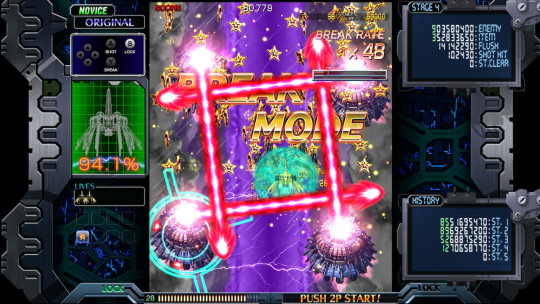
A game I’ve technically owned for years now, however the lack of a Windows PC has held me back from playing it - with this debut on the Switch finally granting me the opportunity though to get hands on. Although I’d gleaned plenty from watching super players decimate it before now, even my feeble credit feeding through the game’s five stages has given me plenty of additional appreciation for just how good it is.
It looks brilliant, with chunky, detailed enemies animated beautifully as they move about the screen. The music pounds along to an energetic beat, and the game keeps a solid pace all while plenty of bullets swarm around you in creative and considered patterns. Turning the tides with Break Mode is an incredibly satisfying way to take control of hairier moments, and while I can’t speak for every intricacy of its scoring system, I know that it’s developed by a team that demonstrably understands the value of these. What I can more reliably add to that discussion is that you’re unlikely to find yourself reliant on any one hook to find your fun though; even the most pedestrian appreciator of the genre should find plenty to enjoy. Thoroughly deserving of its regular appearance alongside the biggest names in the genre.
Holovista

There’s often a reasonable amount of scepticism that comes from some folks when you talk of gaming on a mobile phone. Flipping the conversation though, and instead to talk of one of my favourite advantages of the format, it’s great that a developer can lean on the familiarity and the personal connection that you have to the device you’re playing on. As a device that lives by your side 24/7 and increasingly encroaches further into every aspect of your being, Holovista leverages this connection amazingly, spinning its story in a series of interfaces that mimic how your phone acts when you use it yourself. Taking pictures and interacting with people in particular are key interfaces, and that are done in a way that neatly puts you right into the shoes of their character.
It begins with said character taking an interview for a new job that is hoped to herald a new tide of good fortune, and promptly introduces the circle of friends that are there to help with this and that celebrate alongside. As you learn more about the job, things slowly begin to get a bit weird, and then take a turn that is something akin to Black Mirror meets nightmarish introspection. Though not overtly unpleasant, there are some memorably unsettling moments along the way. Sensibly, it does have content warnings that offer some sound advice for those it might not sit so well with, but self-care does end up being a central takeaway from the game as a whole as well as for its cast. On the back of circumstances we’ll generically chalk up to this year’s being what it is, this ended up feeling like a lovely little palate cleanser - a considered refresh, thoroughly original, and a very worthy afternoon’s entertainment.
The Legend of Zelda: Link’s Awakening
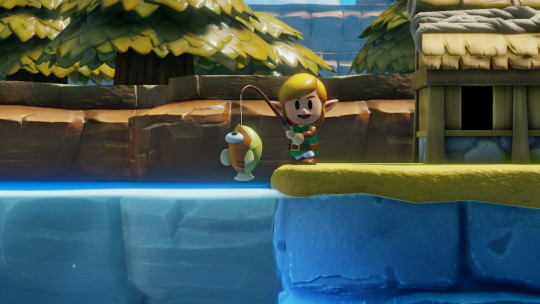
One thing that’s always been great about Link’s Awakening came as a result of the technical limitations imposed by the Gameboy - that the Zelda format needed all the fat trimmed, while the mixture of puzzles and action were to be distilled down into their most potent and compact form. Even with the (entirely optional) extras they’ve slipped in with this remake, this still shines through in its design now, where it couldn’t be any further removed from the risks of overly long, dragged out pacing. A small overworld it may be, but it’s full of variety, secrets, and memorable moments. Dungeons are similarly economical with its good ideas - giving you new tools, laying out smart ways to break you into their use, and then letting you get on with things.
While the remastered music is also utterly charming, the real upsell here is the total visual do-over; its tilt-shifted cartoon aesthetic pushing each and every scene to look like a shiny, hyper-cute diorama. For all of the different visual styles that the series has dabbled with in the past, this one definitely feels like the right match for the light-hearted whimsy that comes through from the story and the characters. That’s not to say that it’s flawless either - the blurring at the screen’s edges can be overly intense at times, and the overall presentation does cause the performance to stutter and feel a little sluggish at times. I point at these things only given the bar is raised so - something unavoidable when you already know a game is a stone-cold classic from the off.
Astro’s Playroom
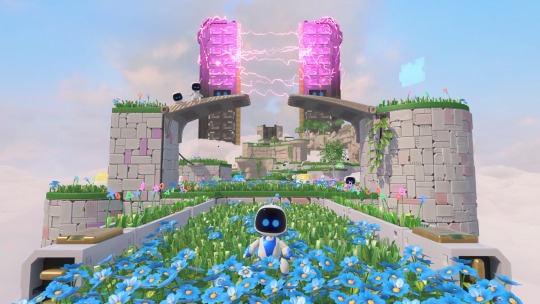
Coming pre-installed on your shiny new (and hopefully not scalped) Playstation 5 console, Playroom begins as a humble introduction to the capabilities of the Dual Sense controller. Touch control, haptic feedback, adaptive triggers and the like are introduced and may well generate some cooing and low-key positivity, however this enthusiasm is elevated by a mighty factor when the game truly begins and everything is put so deftly into practice.
It’s not a complex or particularly challenging title as far as 3D platformers go, with frequent checkpoints and no life counter in sight. Any mould-breaking to be done comes instead from the diversity in how you control various sideshows, with the entire kitchen sink’s worth of interface options being showcased as you climb into a monkey suit, blast off a rocket ship, bounce around as a pinball, and so on. All of these demonstrate ingenuity that could’ve easily gone awry, yet are quickly understood, and grounded in a level of both tactile and in-game feedback that maintains a natural feeling. The game’s worlds serve as virtual tours through colourful, fantasy depictions of hardware components that demonstrates an excellent level of both pride and playfulness, with fellow bots littering both the through-fare and the unbeaten paths, dressed up and enacting smart homage to generations of games and their characters, all while Playstation-themed collectables are doled out in tandem alongside smart, well-natured puns. It arguably borders on propaganda at times, such is the intense positivity. That said, the more extensive your tenure is with Sony’s platforms, the more likely it’ll dull your better judgement to this, instead letting slip a grin at what is essentially the grandest love letter to all things Playstation, and the warmest, most celebratory pack-in for a new console Sony could have ever hoped for.
The showcasing of new features and hardware aside, it’s also a subtle and unofficial coronation of Astrobot as Sony’s newest (and best) mascot. There’s been plenty of candidates in the past who’ve half-heartedly assumed to own the position, but it’s the silent, cheerful charm which makes Astro that much more of an endearing figurehead. G'wan the little guy.
No More Heroes 2: Desperate Struggle
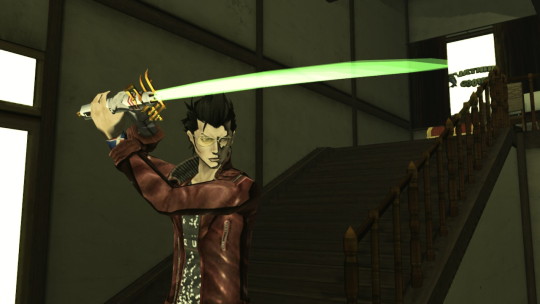
For someone that loves Suda51 and adored No More Heroes, my reaction to No More Heroes 2 on its original release was comparatively tepid. With a third game due next year, this re-release felt like the right time to revisit it and see it through, and although I found some things to enjoy, I certainly found plenty to remind me why I had bounced off it previously.
Roaming about in Santa Destroy between missions is gone, instead replaced with a short check list of destinations. While not a fan of the change myself, this isn’t necessarily a bad thing - though it does give a misleading impression of tightened focus that is very quickly lost as it lays out a spread of half-baked, and frankly clumsy mini-games. As well as being your prime source for money and upgrades, these do a lot to artificially increase the length of the game, and put simply, they’re just not fun enough to warrant this level of prominence. Even the main story has frequent moments where it veers away from the core 3D hack and slash gameplay, and again, these do more harm than good to the game’s flow.
The fighting underpinning it all has undoubtably been done better since by any number of titles, and though imperfect, it is still serviceable and enjoyable for the most part. Boss battles definitely hold the lion’s share of the game’s highlights, but there’s a few that also stick out with some poorly executed designs that tars its lasting impression. Shades do remain of the ridiculous, irreverent charm of the first game, although they are certainly more infrequent, and a more modern lens also brings into question just how sincerely we should take the sending up of Travis, when cast upon a backdrop of frequent fanservice. Not the best sequel then, but let’s hope 3 gets things back on track.
3 notes
·
View notes
Note
Do you think they could make Azula gay in the netflix live-action? Many people in the fandom seem to think she had a thing for Ty Lee. I don't see it, but do you think they could retcon the show just to pander to shippers?
Somehow I knew this sort of question would pop up in my inbox one day. I just did. Such foresight powers I have (?)
Anyways, the answer got pretty long, but I hope it’s comprehensive enough in regards of why I don’t think it’s likely, why, even if it happens, we shouldn’t freak out about it regardless of if it negates our headcanons, and why, on top of it all any characterization the ATLA cast gets in the liveaction should be judged as part of a second timeline, removed from the first, and analyzed as such.
Alright, first of all... despite what popular opinion these days would have everyone believe, a character’s sexuality and sexual identity are not the only relevant and important factors in them; in fact, I wouldn’t even call them the most important factors unless you’re outright telling a story with very specific socially critical purposes in mind. Yes, you can deal with these subjects in stories that aren’t exclusively about sexuality, and yes, it offers important representation to communities that were largely unseen for the bulk of human history. But making a character’s entire story arc revolve around nothing but sexuality and their struggles because of it is actually a failure at offering good representation? The point in having media featuring representation in the form of diverse fictional characters is based on allowing minorities to see themselves in this kind of content and for majorities to understand these minorities and their stories are just as valid as theirs are. If minorities are reduced to a single aspect of their multifacetic lives, the only thing the story in question would achieve is turning a character with the potential to be dynamic and complex into some flat minority stereotype, throwing away the countless human complexities through which media can tell rich and important stories that do provide genuine, quality representation to these communities.
Ergo, if Azula were written as a gay character in this Netflix adaptation, this aspect of the reworked character should not, and frankly, CANNOT, be the only thing that matters about her. Azula has a large role to play in this story, a role related to the war, her family, her friends and her nation, and a lot of her complexities stem from how she deals with all these subjects, none of which have anything to do with romance or sexuality. Therefore, I’m pretty sure a lot of us loved her character for reasons that had nothing to do with her interactions with potential love interests, whether they’re of her same or opposite sex: Azula has always been SO MUCH MORE than whatever we’ve headcanoned her sexuality to be, and this is something I hope everyone keeps in mind for this liveaction show.
We need to stick to our priorities, to a fault, as Azula’s fans: whatever sexuality or love interests she’s given, if she’s given either thing to begin with, her story isn’t exclusively about that. So, if Bryke decide to alter this aspect of her original characterization by dialing up Azula’s love life, it’s not the driving aspect of the character and it’s not the only thing we should be concerned with when it comes to her new portrayal in the future liveaction show, regardless of whether said sexuality agrees with our headcanons or disagrees with them.
Alright, then. After that particular clarification had been made... I’m of the opinion that Bryke have indeed pandered to shippers and fans in the past, namely in their sequel show and certain later announcements related to it, announcements that were basically the LOK version of “Dumbledore was gay all along but I thought it’d hurt the book sales and that’s why I only said so in a press conference after the final book was a bestseller and my bank accounts were overflowing” (by which I mean, the last-minute sudden “Aiwei (the dead guy) and Kya (Aang’s daughter) are also gay” comments Bryke made post-Book 4 to convince people they were aboslutely pro-LGBT and their world was very diverse despite said diversity only became known in the final scene of the show and was never portrayed positively or properly through these side-and-background characters...?).
So, would I say, categorically, that Bryke would NEVER write Azula as a gay character if they thought it’d make their show more popular? Nope, I can’t. I really don’t trust them enough to think they’ll prioritize top-of-the-line storytelling over pandering to the crowd that will cheer them on most loudly.
THAT BEING SAID...!
The story they told with Azula in ATLA, despite what certain people are convinced of, had a very straight-forward message, one that I didn’t like very much, especially since that message seemed to render irrelevant the character’s incredible storytelling potential and remarkable complexities. Where Azula could have been so many things, in the show’s finale she became some sort of flat, sad warning stating: “don’t try to control people through fear or they’ll turn against you and you’ll end up all alone.”
As much as I have no doubts Bryke will want to incorporate new themes and somewhat “update” ATLA into more progressive times, I really doubt they’ll sacrifice the story they’re apparently so proud of having told through Azula only to pander to a specific part of ATLA’s audience. For that matter, there’s been a growing movement promoting many same-sex ships and trans interpretations of virtually ALL ATLA characters, so if they were to pander to the fanbase through Azula, why her? And if they do pick her, why stop there? If they do stop there, then they’re not being inclusive enough with their fandom. Why satisfy one portion of the fandom and not satisfy the other ones too? :’D
Worse yet, accusations of foul play will absolutely be guaranteed to rise when a potentially gay Azula isn’t given a redemption (because, considering the latest Azula-related comments by the creators and comic writers, they’re not likely to do it this time either), because “irredemably evil lesbian trope, that’s so sexist and homophobic!” And with that, the long, glorious time ATLA has spent as the golden, poster child of western animation will suddenly be overrun with the very same hysterical purity police that has overtaken all newer fandoms and filled them with antis who attack creators, writers, actors and other fans for creating or supporting “toxic” content.
Point and case being... if they don’t stray from the story they already told, they have a slam dunk since a lot of people will love the show if it’s virtually the same as the one they watched when growing up. All they have to do is alter a few events, maybe expand on a few things, stall the story for a few more years so the actors can age realistically and not be overworked... and tadaaaah! You have a blockbuster! Change fundamental aspects of characters by adding new factors to pander to certain fan demographics? You’d basically be poking a wasp’s nest and hoping they will turn out to be honeybees instead, ESPECIALLY if the character being coded as LGBT is either evil or fated to die, as both those tropes are what seem to incense that side of fandoms more than anything else.
If they want to write Azula as openly gay, they’d have to alter her general character message and whole arc to avoid the guaranteed problems I’ve pointed out up here. Paired with this? They’d have to retcon their recently established “the Fire Nation became homophobic in Sozin’s time!” canon imposed by LOK’s comics, so, if they stick with this tidbit of recent LGBT info, a gay Azula would most likely have to be a highly repressed lesbian who can’t even accept herself? It’s not impossible to tell that story... but it kind of feels counterproductive, and absolutely discouraging too for people who are struggling to come to terms with their own sexuality to see themselves reflected in a repressed character who most likely will meet the same depressing end she does in ATLA.
Now, my final point: again, I can’t say it’s impossible that this might happen. But EVEN IF Bryke decide that this is how their new story will work, and the new Azula will be gay, and they change everything so it’s non-problematic and they successfully avoid being chased with pitchforks by the purity police...
A new characterization doesn’t negate the one from the original show in the least. The first ATLA is what it is, a finished product that can be judged and interpreted in a thousand ways, and has been, for the past 10+ years. A new canon does NOT overrule an old one, a thought that I’m sure the very same purity and nostalgia police I’ve mentioned will absolutely adhere to once the new story changes ANYTHING and they don’t like it. Whatever new possibilities they test out with a new story don’t have to be taken as facts that apply to every iteration of the characters. For reference, imagine judging every Marvel comics character for the actions and behavior of their MCU counterparts. Imagine people raging at Peter Quill in the comic books because he’s in love with Kitty Pryde and how DARES he cheat on Gamora with her?!
... Just how would that make any sense? :’) Likewise, it would make no sense to behave this way with ATLA and its future liveaction adaptation. What happens in the liveaction concerns the liveaction. What happened in the original show can serve as a guideline for the liveaction, if anything, a frame of reference, but they can (and will) change elements in the story as they please in the new adaptation. However similar as they might be, they’re TWO stories, and they should work perfectly well as standalone shows.
Let’s look at it from the opposite POV, to further illustrate my point: if the new show SOMEHOW made Sokkla canon, unlikely and damn near impossible as it is: that doesn’t make it canon in the original ATLA. Hence, if I were to run out in the streets screaming Sokkla is real and endgame in EVERY POSSIBLE VERSION OF ATLA, the entire world would have every right to throw rotten eggs at me and tell me to shut the fuck up because it’s not true, it’s only real in the liveaction, and that doesn’t have any bearing on the original show.
Same principle applies with a potential gay Azula :’) Even if it happens, it’s liveaction only. The original show remains what it is, and her characterization there can be interpreted and derived from as we see fit.
To close this answer, I confess that I, personally, have next to no interest in this liveaction remake. I can’t even say I’ll watch any of it. For one thing, I’m really annoyed by the trend there is these days to turn animation into liveaction, because it seriously feels like an underlying way to say that liveaction is somehow the superior choice for audiovisual storytelling and that really grinds my gears. Animation has been fascinating media for me for years, I’ve always felt it’s more versatile than liveaction, and if I ever happened to write something that gets an onscreen adaptation, I’d probably choose animation over liveaction even if I’m not given a choice on the matter :’) So, for starters, I’m not happy with the notion of a liveaction remake for this show. If they wanted to remake ATLA and had chosen to do so with animation, I’d definitely be much more interested. But this way? Uh... not my cup of tea.
So, whatever Bryke want to do with this new product is absolutely their business (same as it was their business with ATLA, frankly). People will criticize it, that’s a guaranteed thing, and people will love it, and people will be angry, and people will be happy. But I’m probably not going to be one of any of these people this time around. The only way I would likely enjoy that show would be if it’s a genuine, critical overhaul of everything they did in the original show, reworking many key aspects of MANY characters, no matter if the main anecdote remains intact. And considering how highly self-critical the recent ATLA-related content has been, I doubt I’ll get my wish. So... good luck to everyone who wants to watch this liveaction, have fun, I won’t spoil it for you by dumping on it this time as I did with the comics, but I certainly won’t be joining any of your parades much either :’D
#anon#the promised polemic subject of liveaction changes#honestly *shrug*#live and let die man#we have the original canon#and I'm way too busy with Gladiator to suffer much about what they'll do with the rest of Avatar#it's highly unlikely the new comics and show will feature anything I'll be dying to see#my optimism with this franchise is basically gone and I'm only here for my corner of the fandom#everything else is other people's business
9 notes
·
View notes